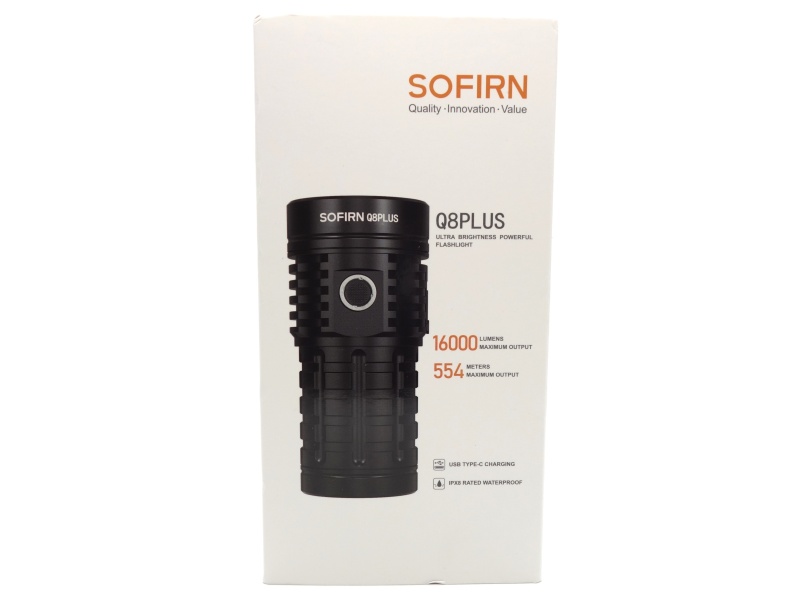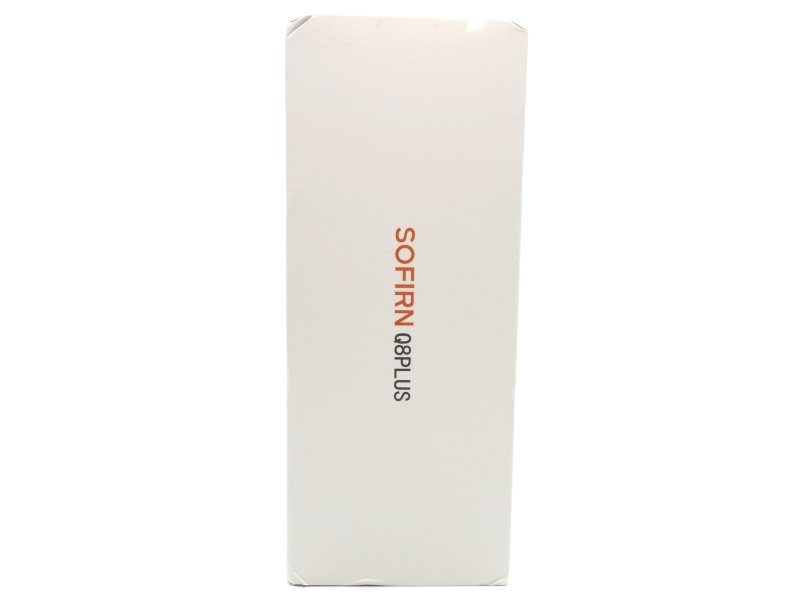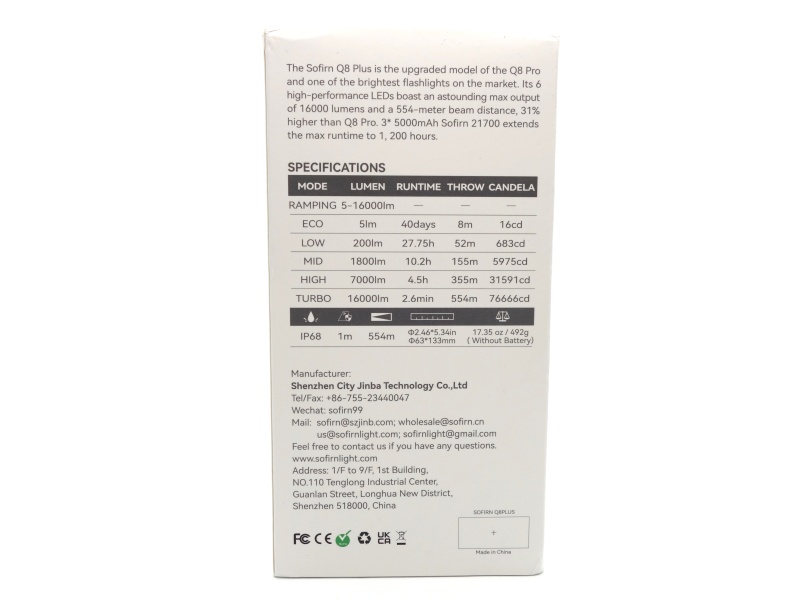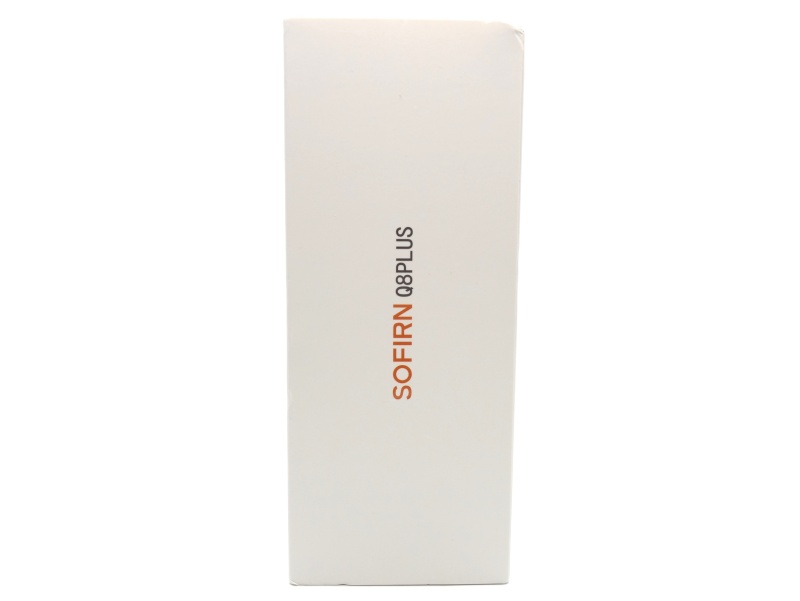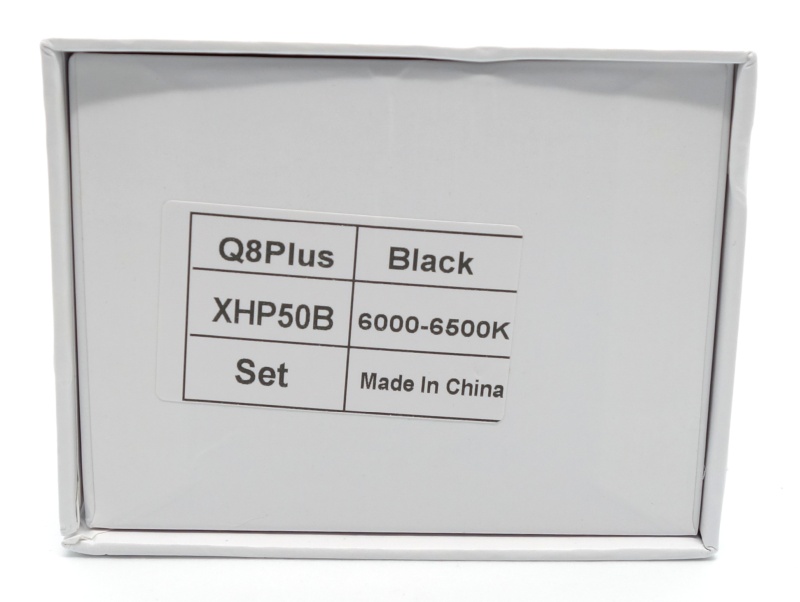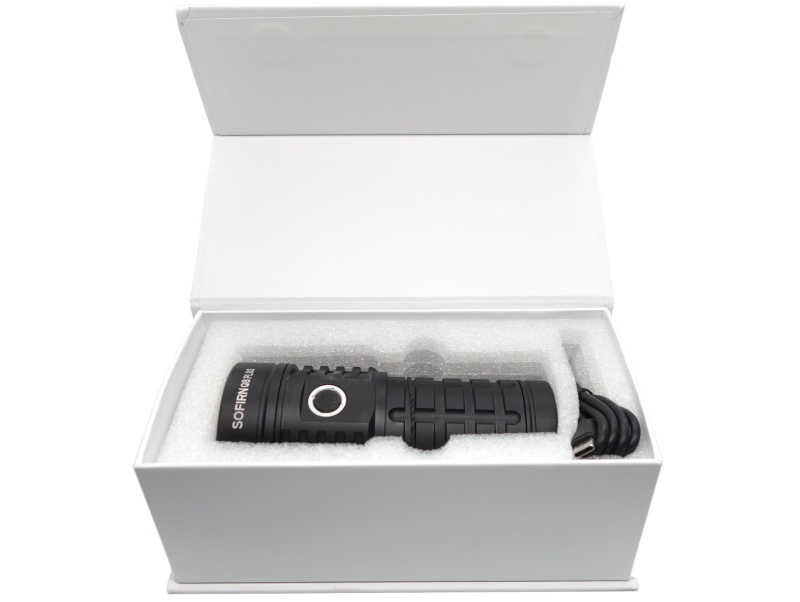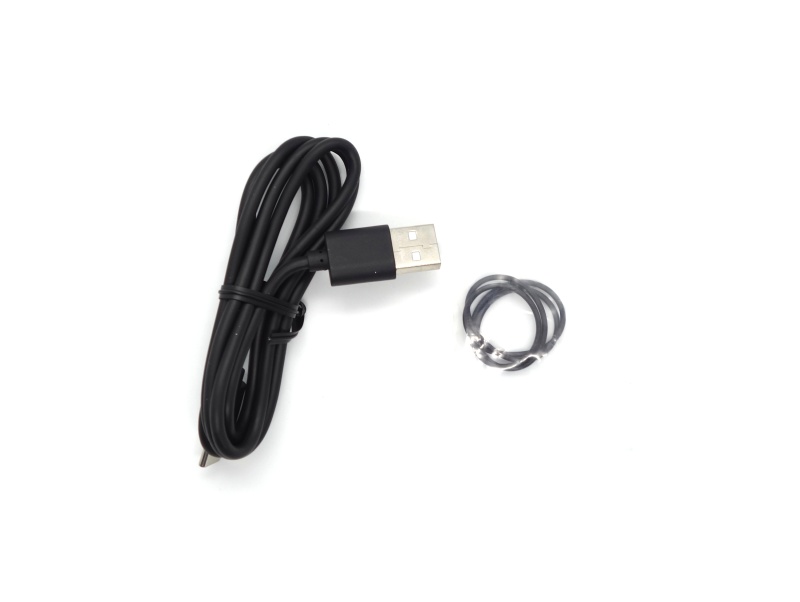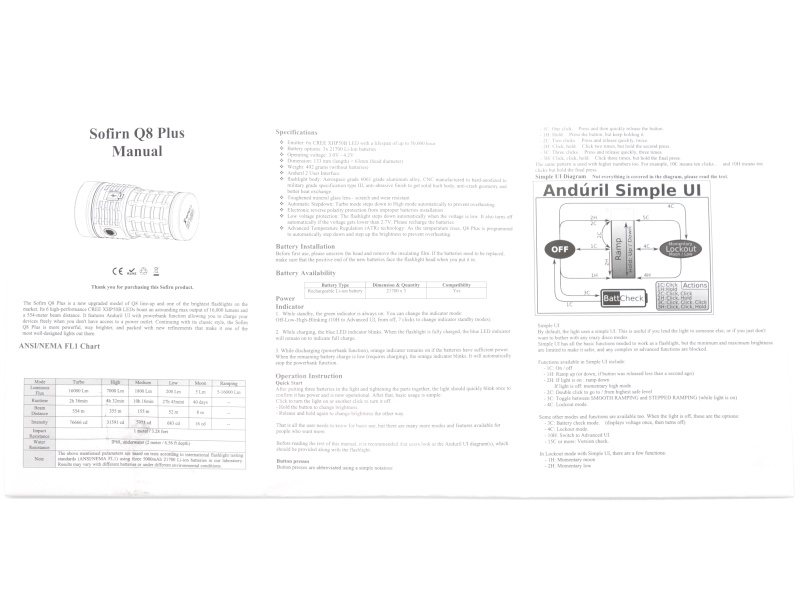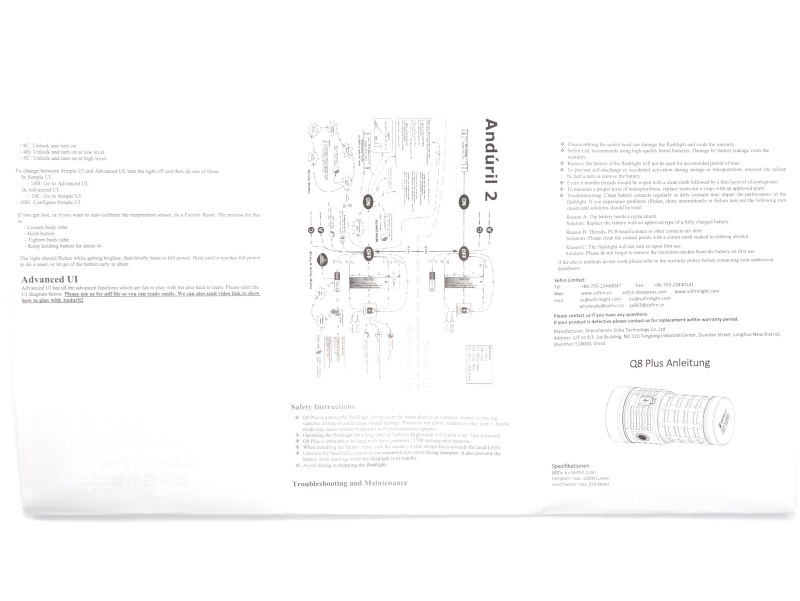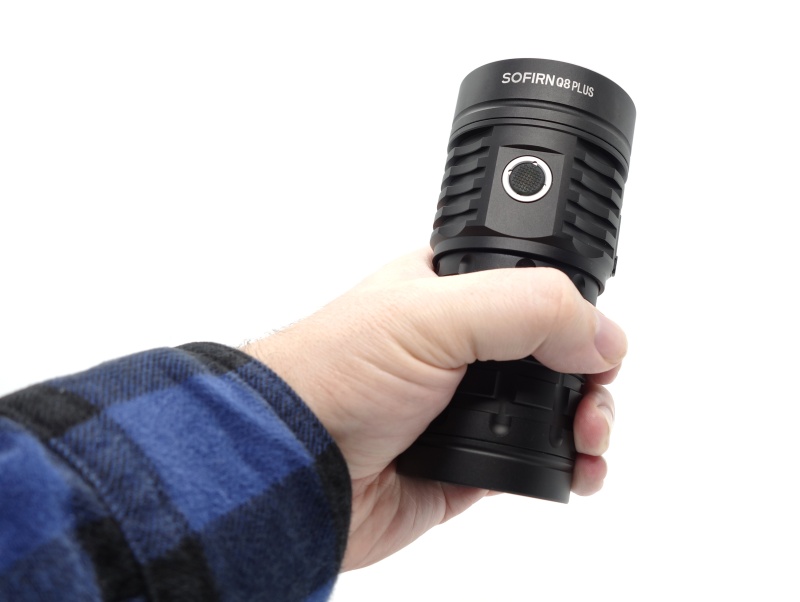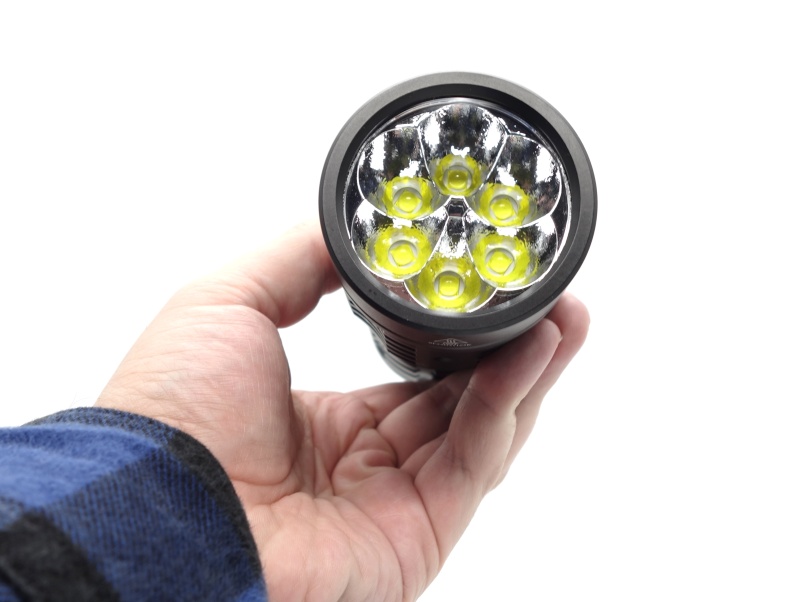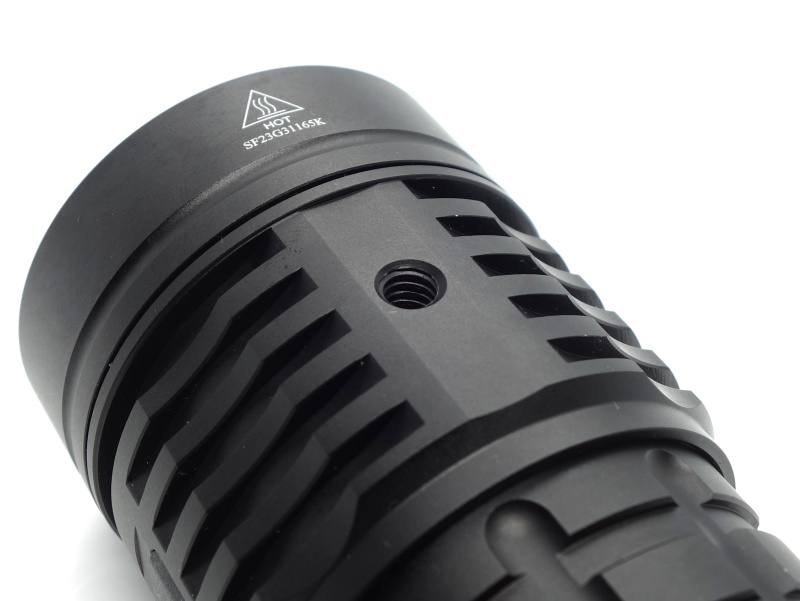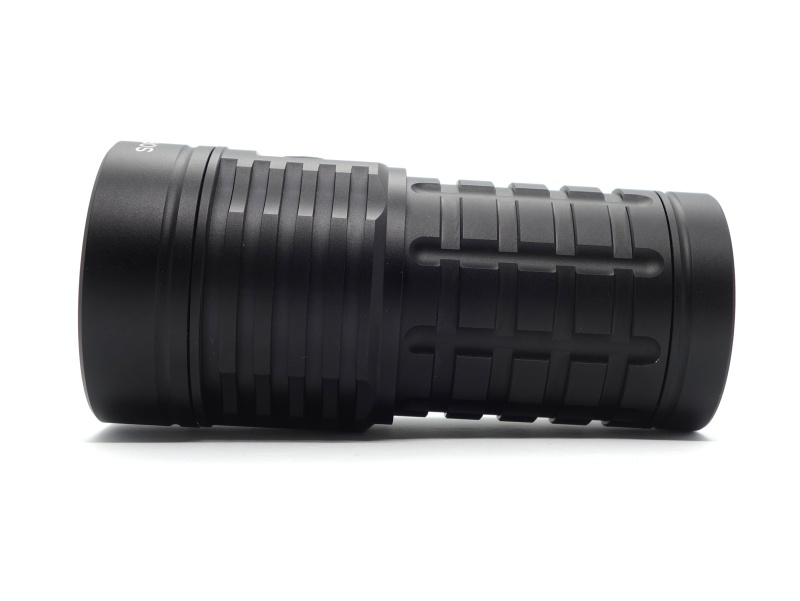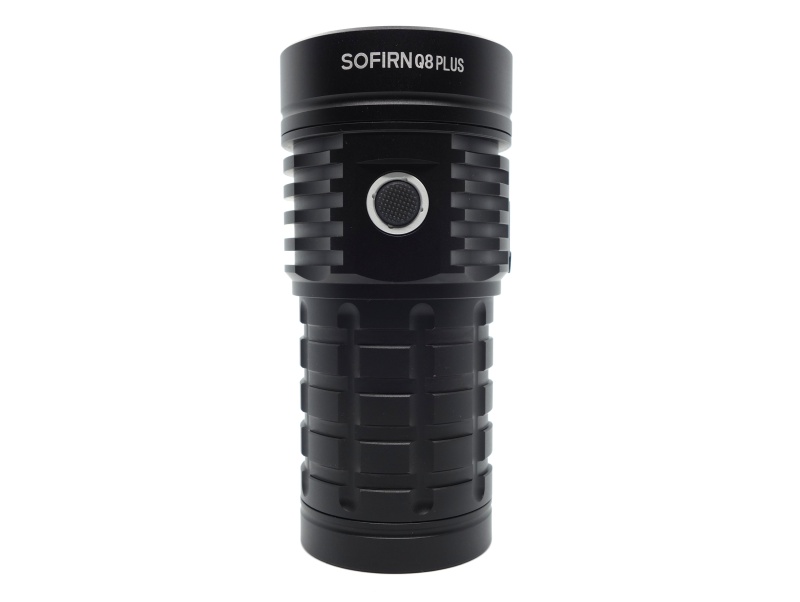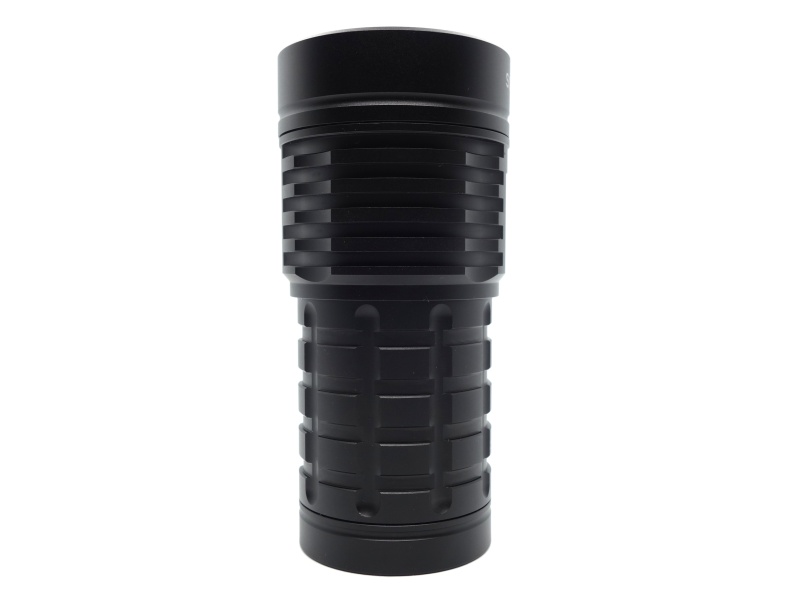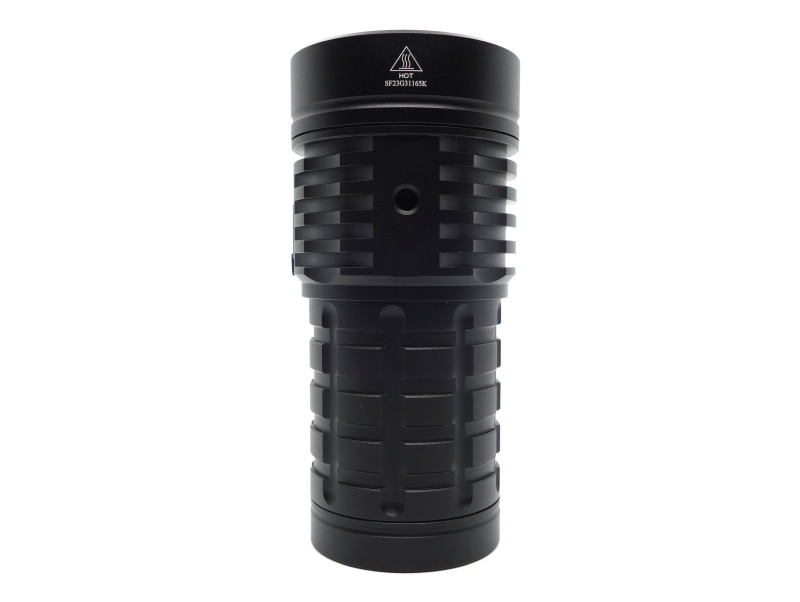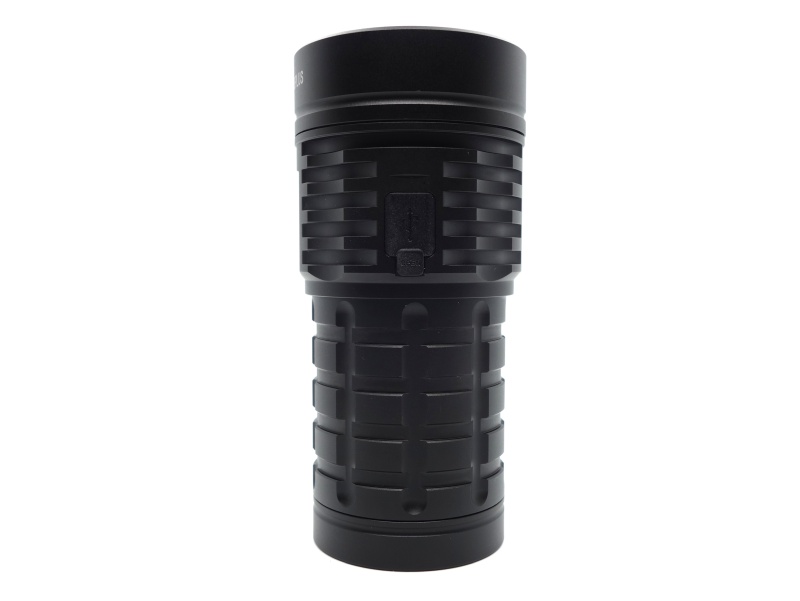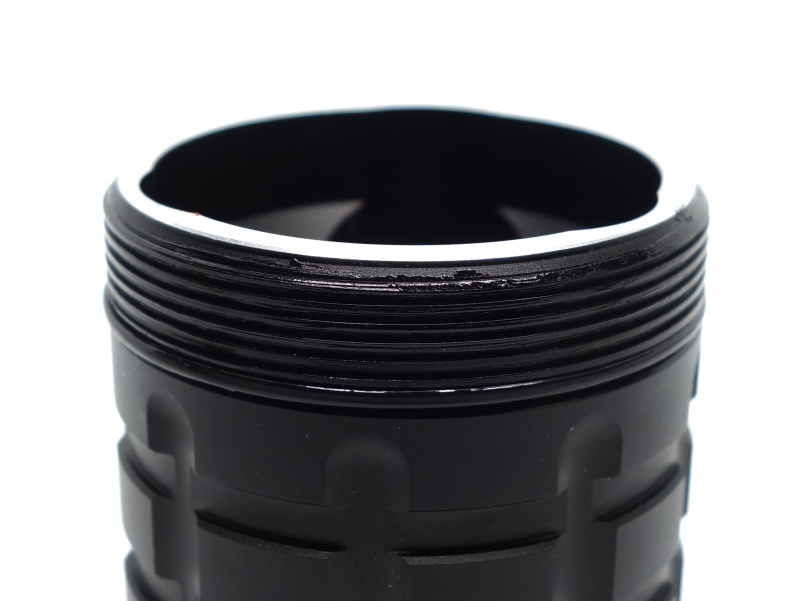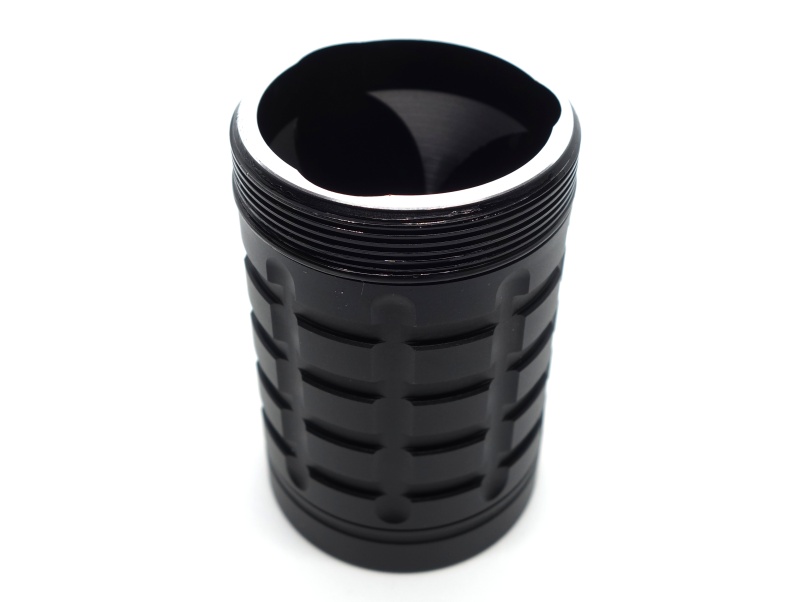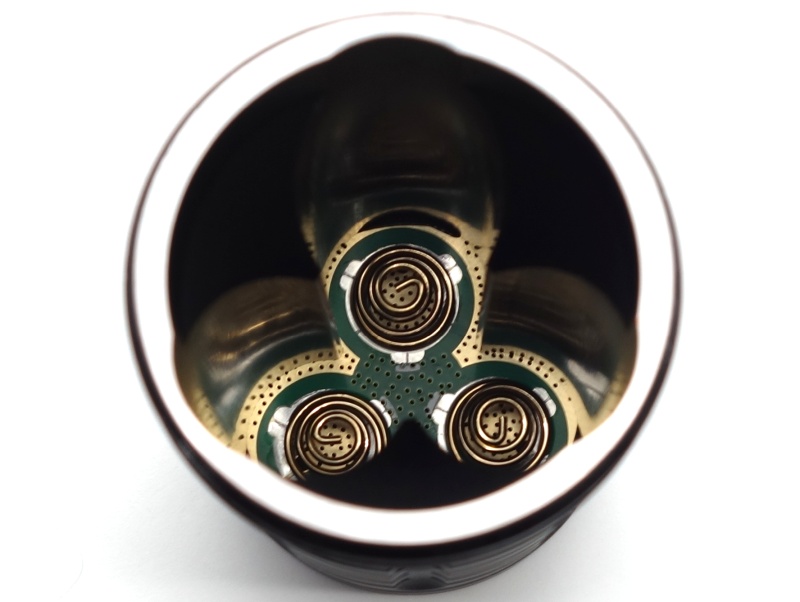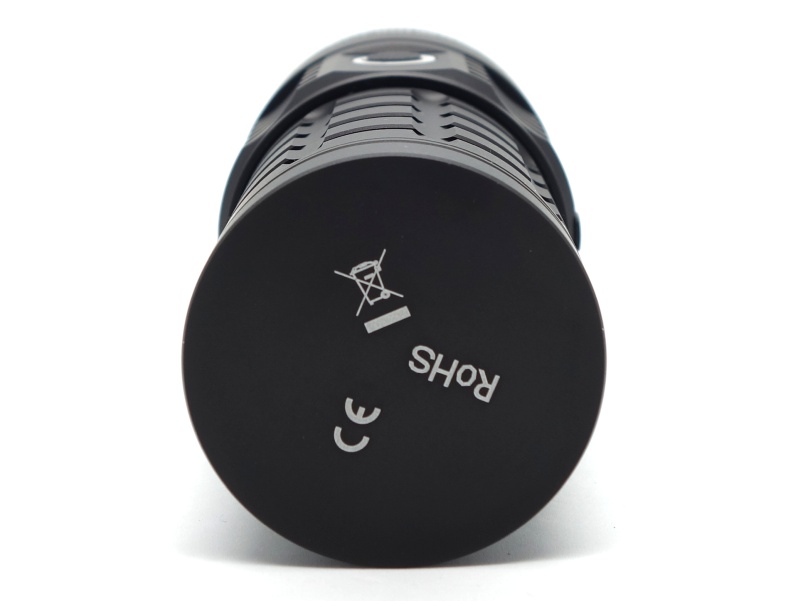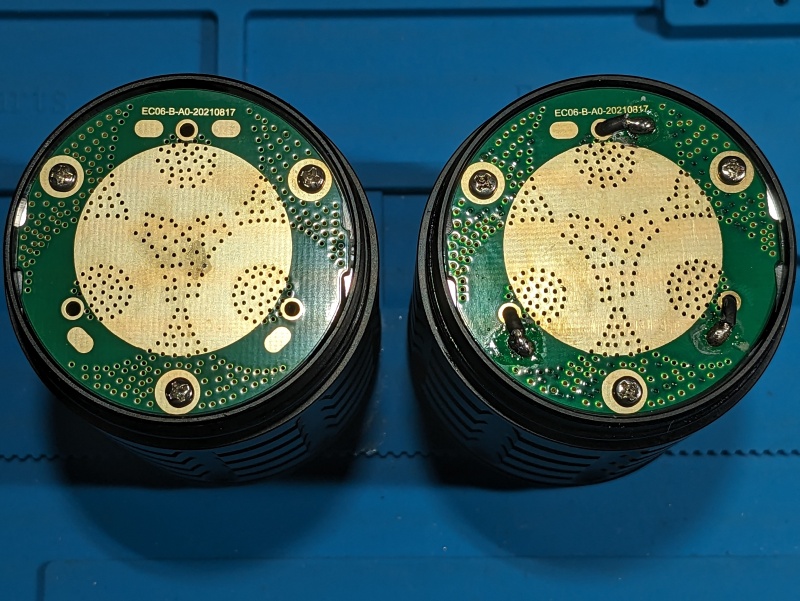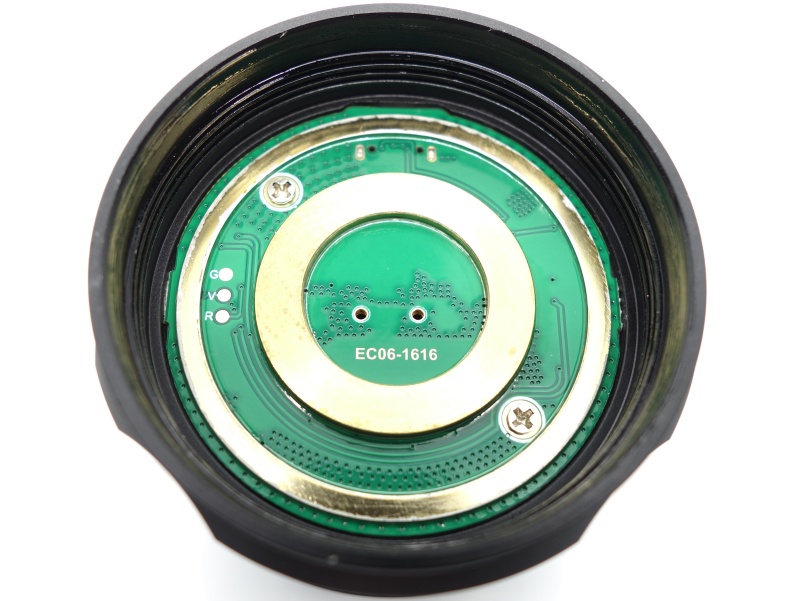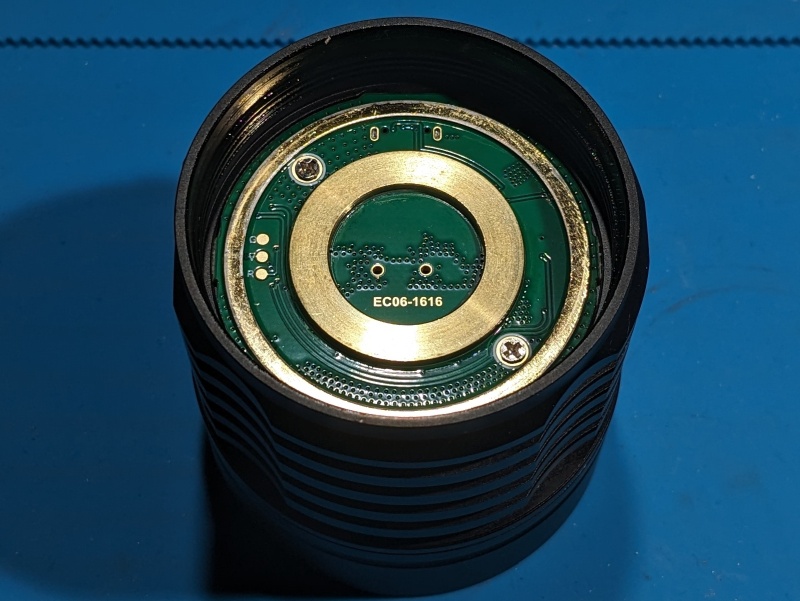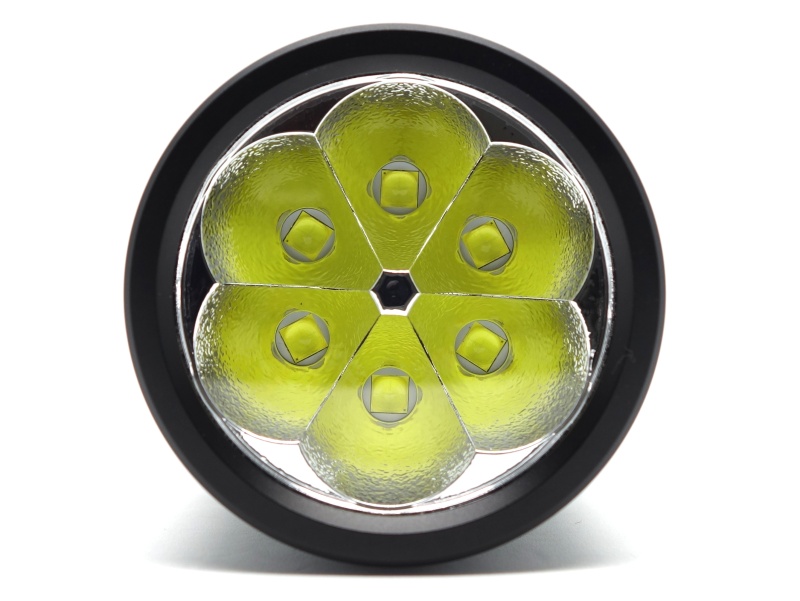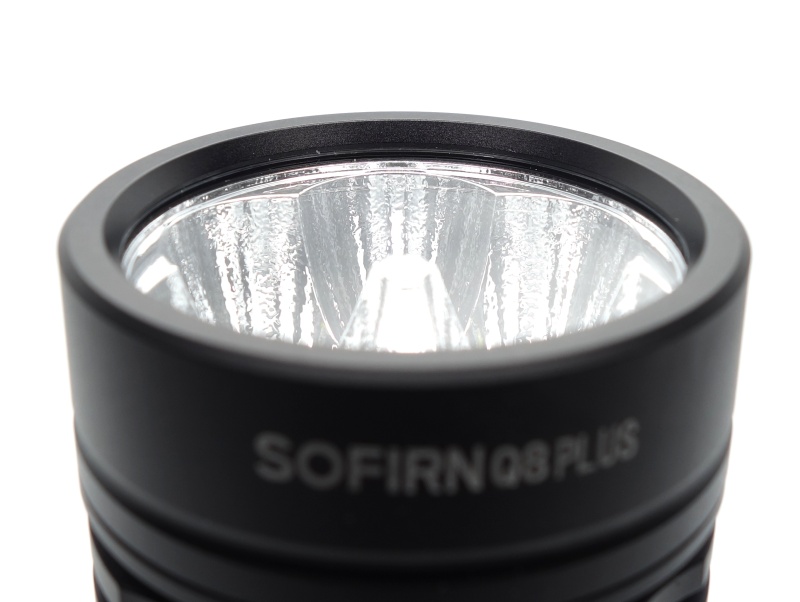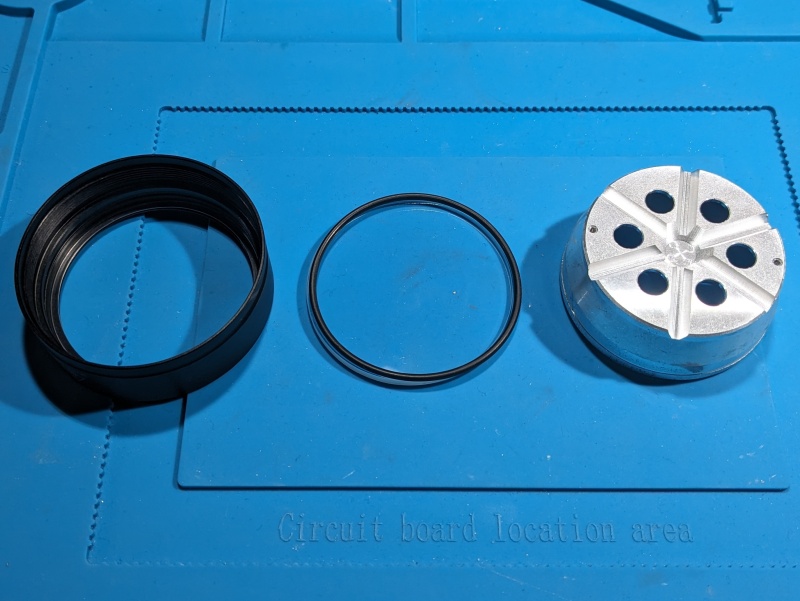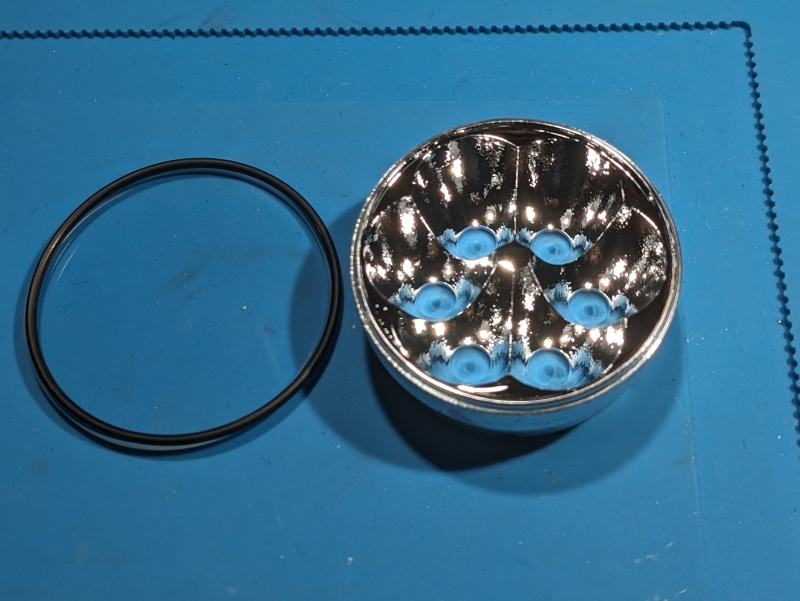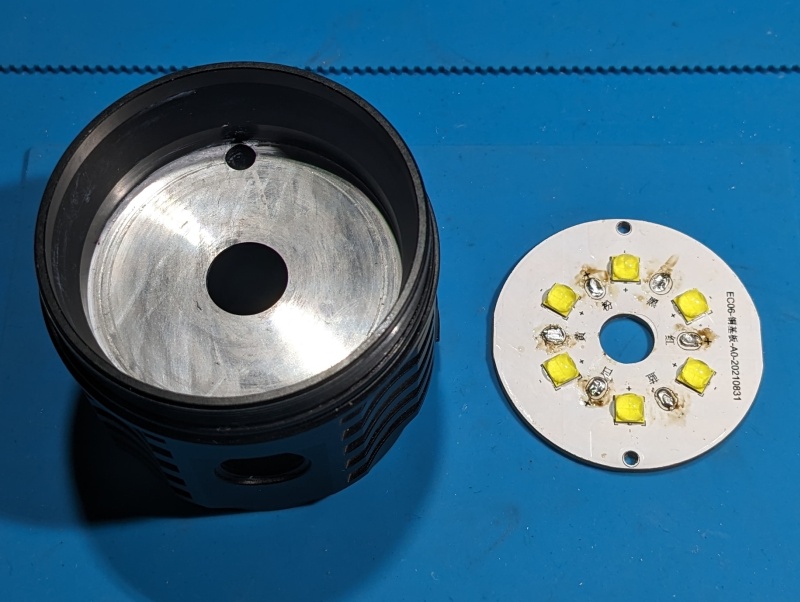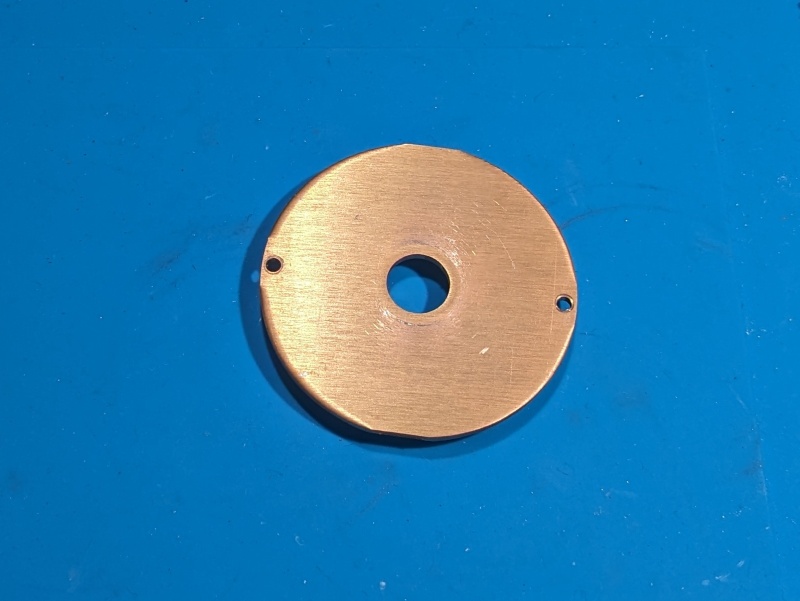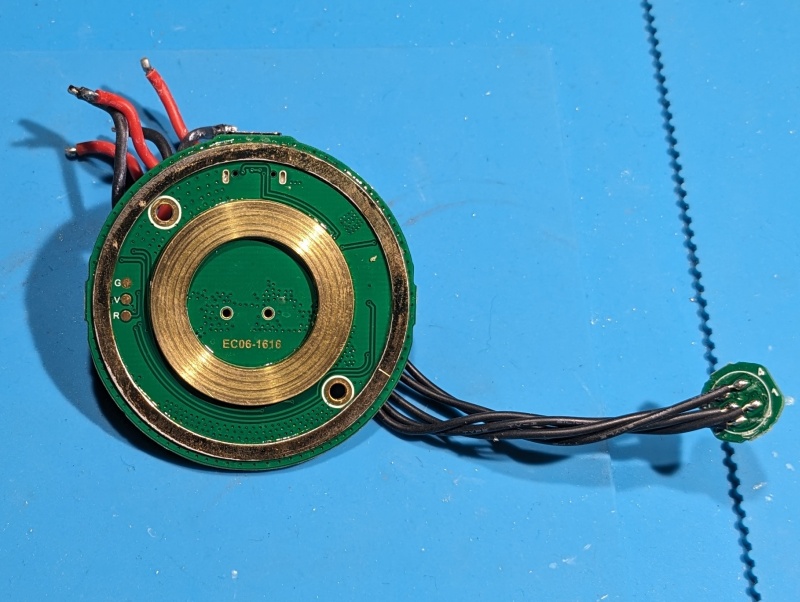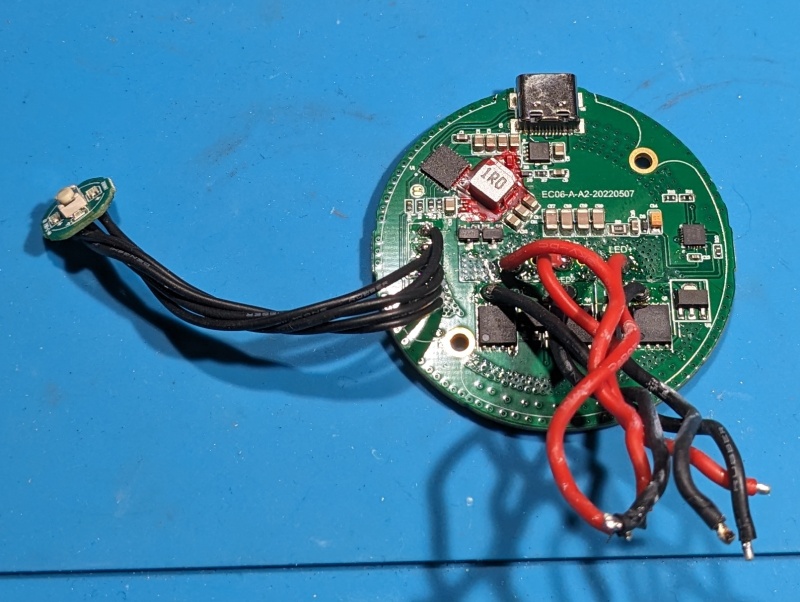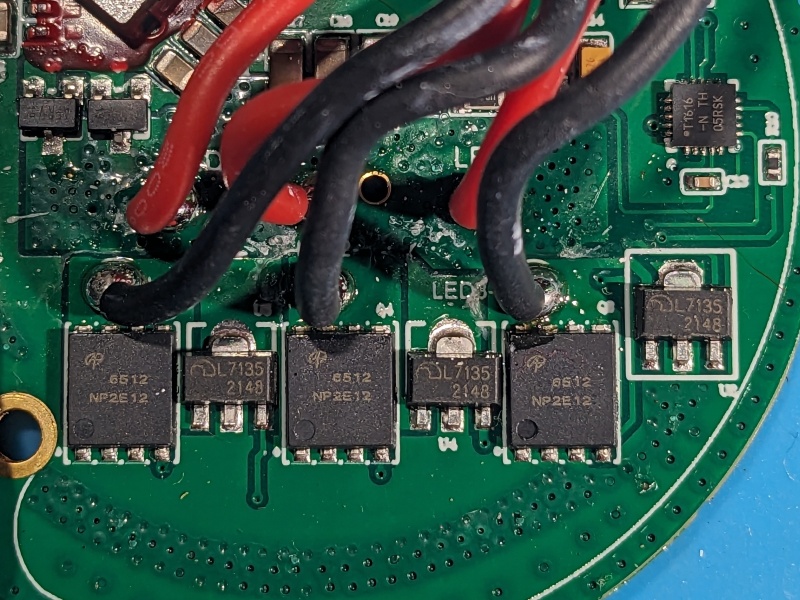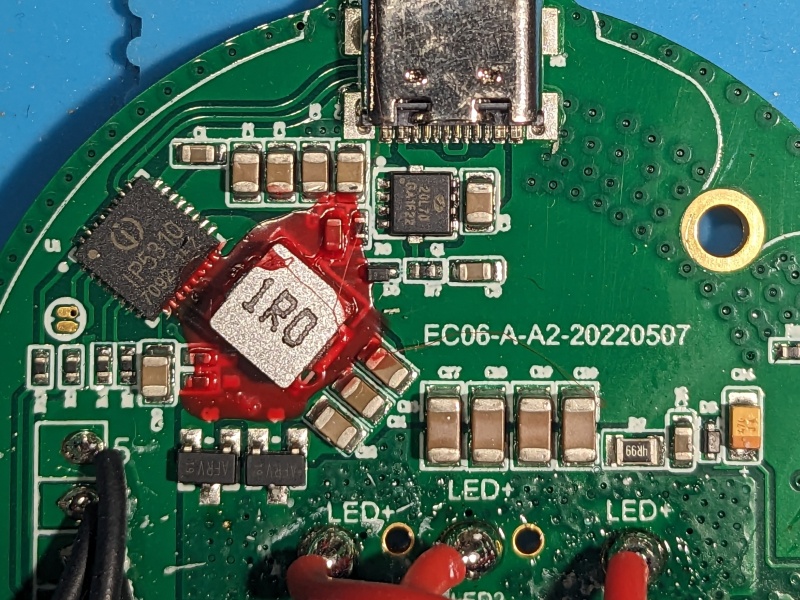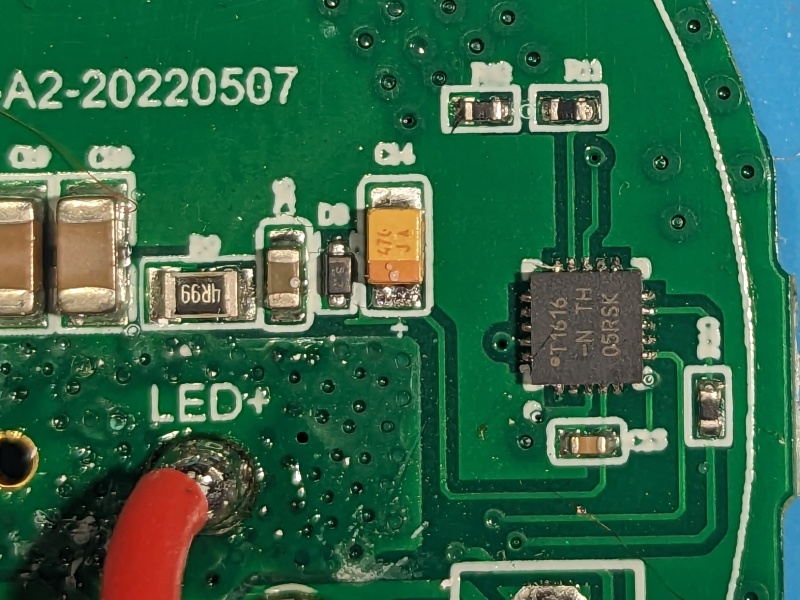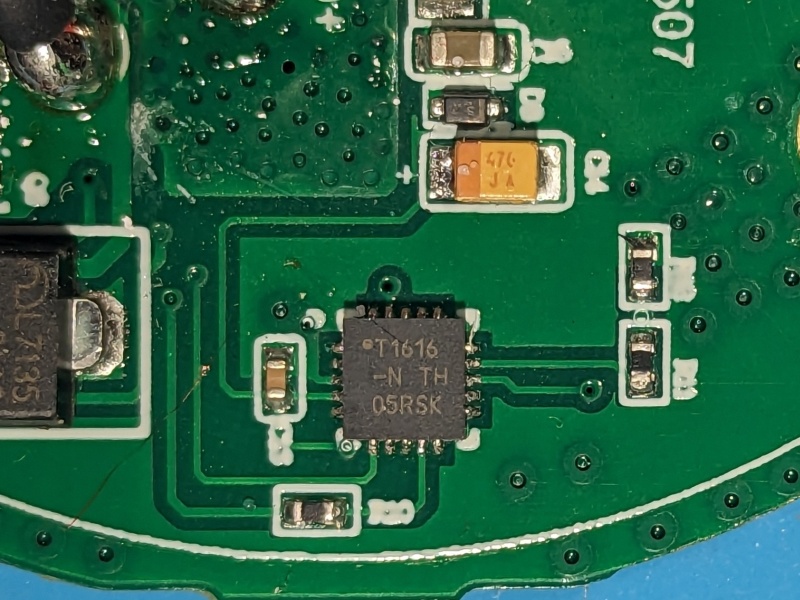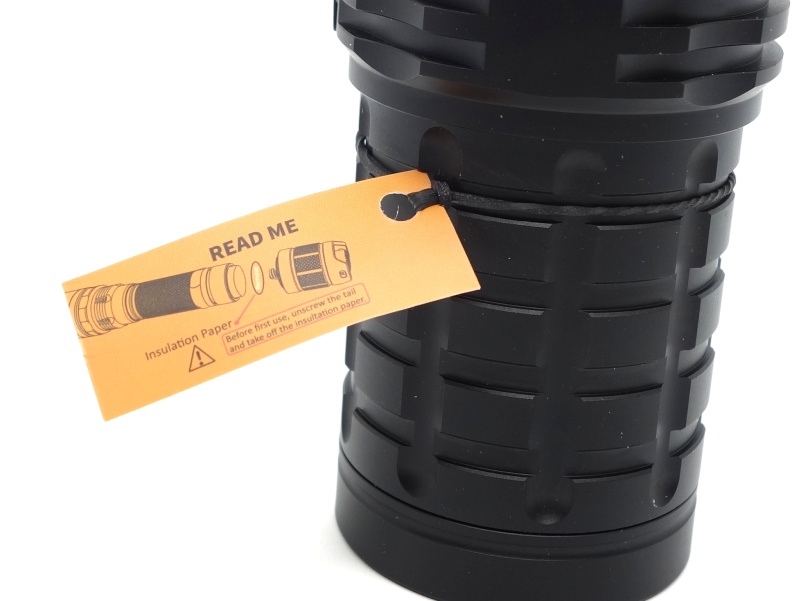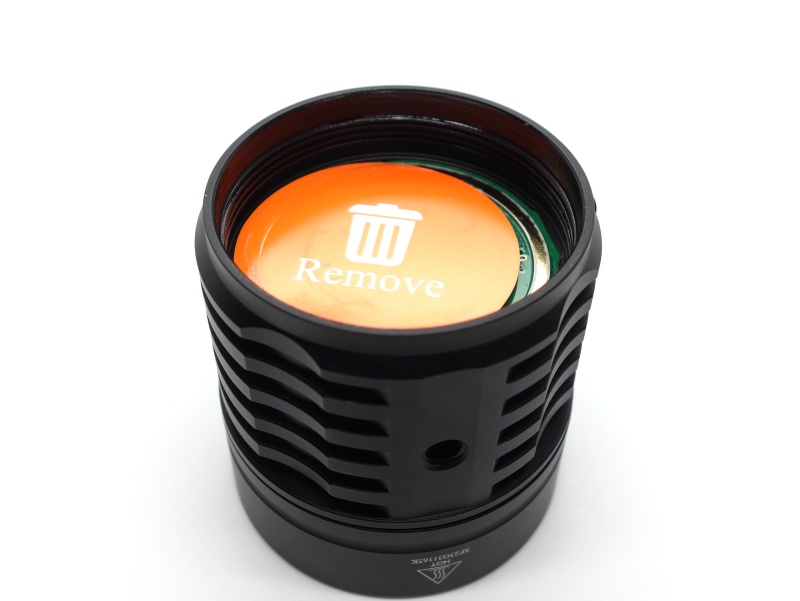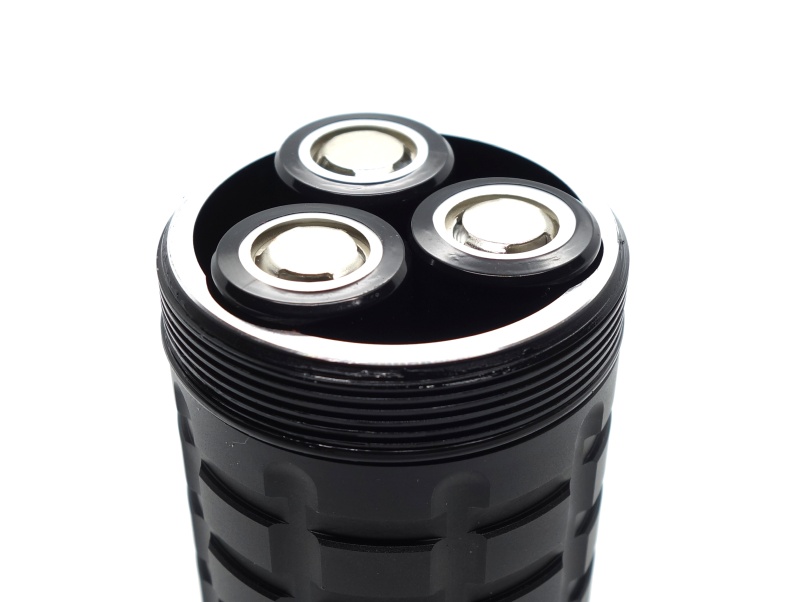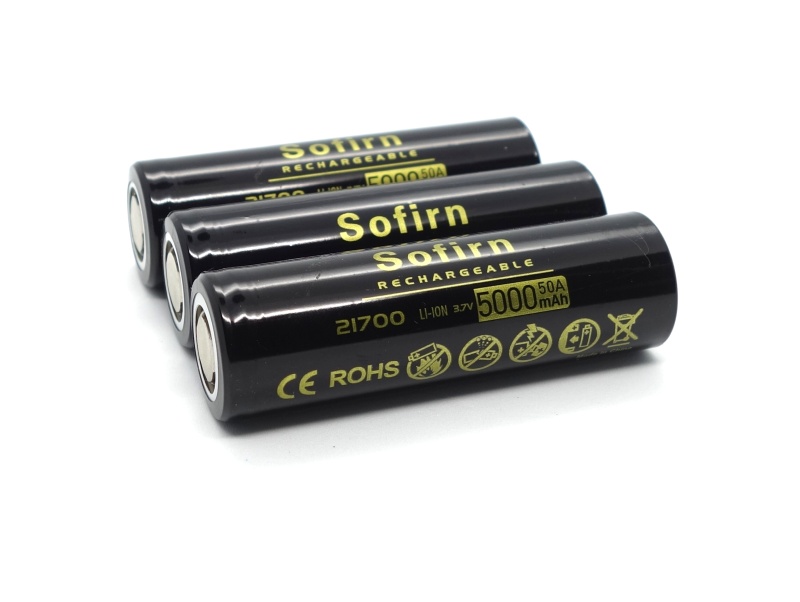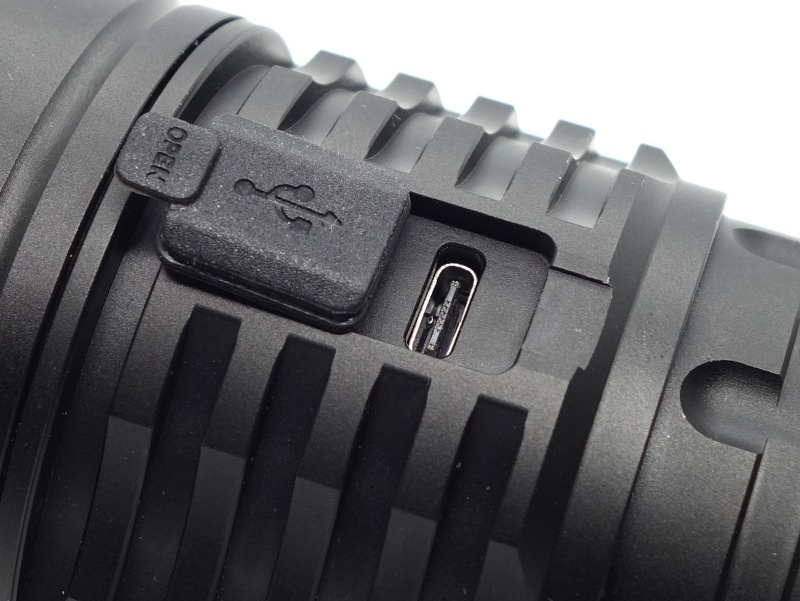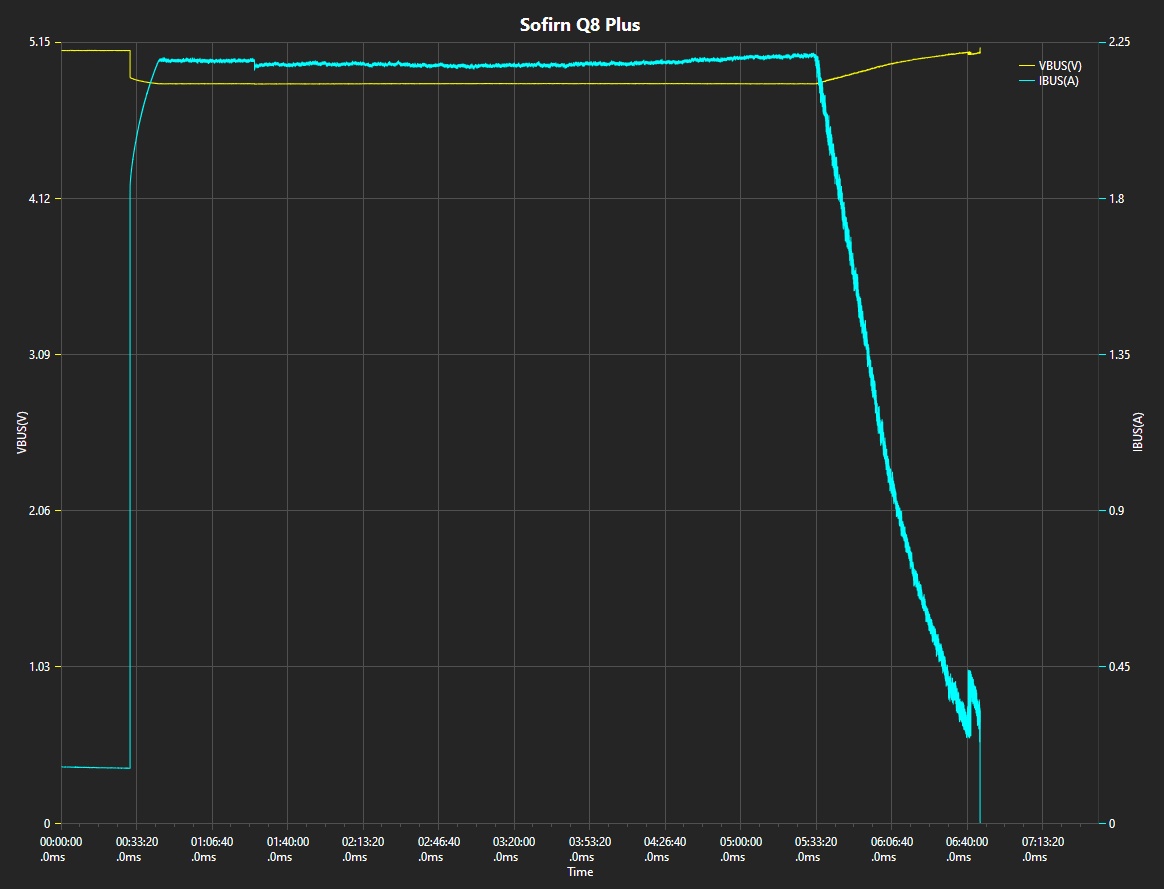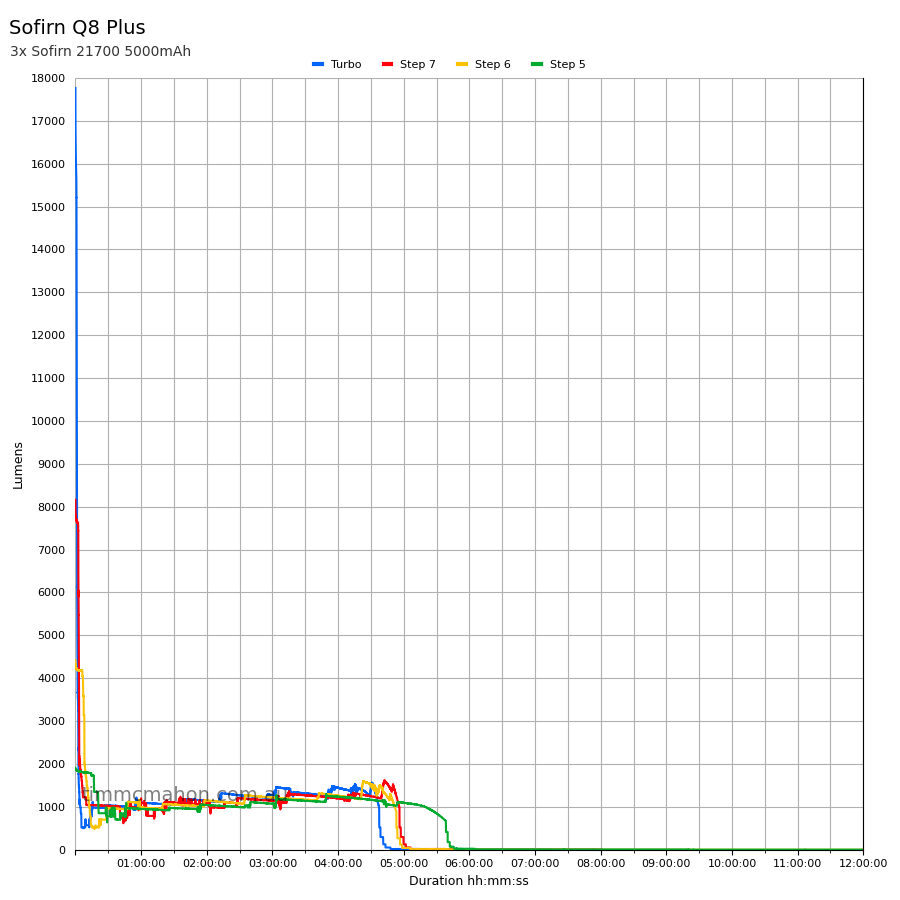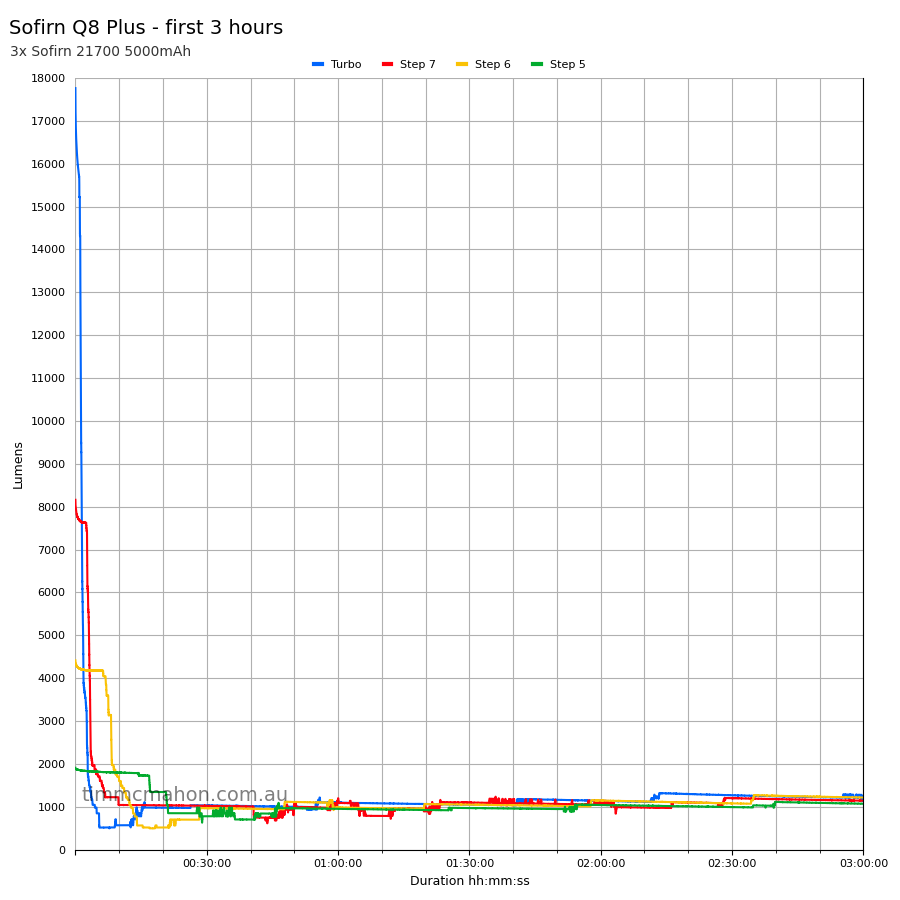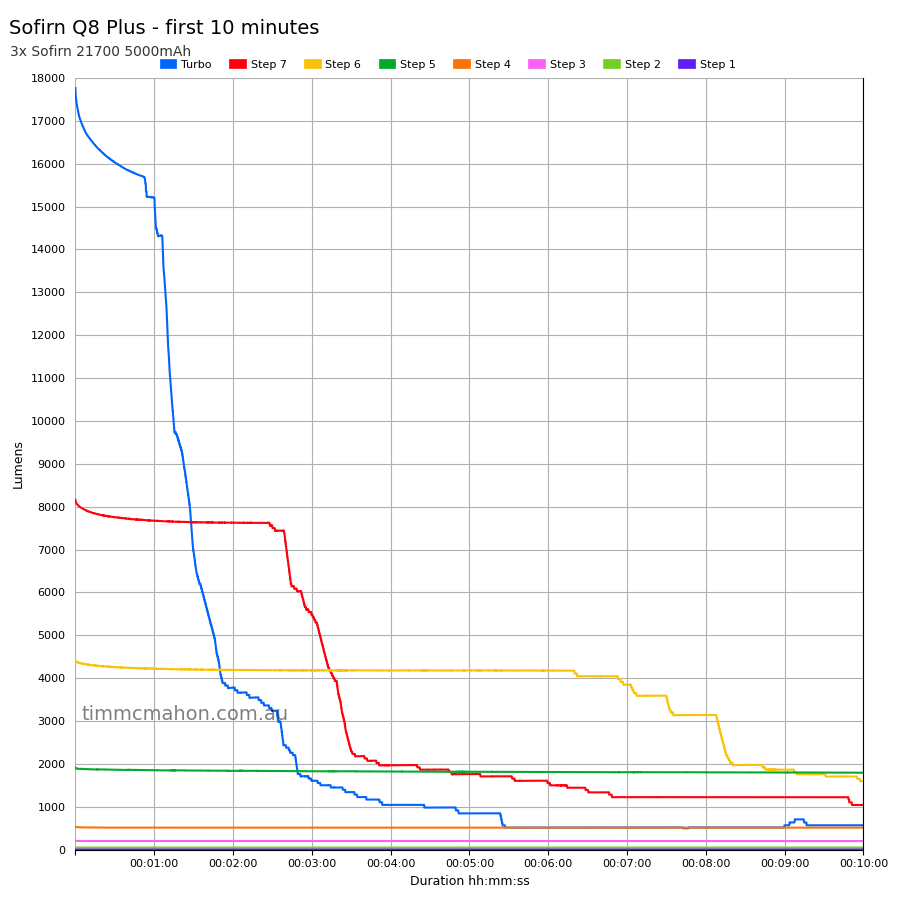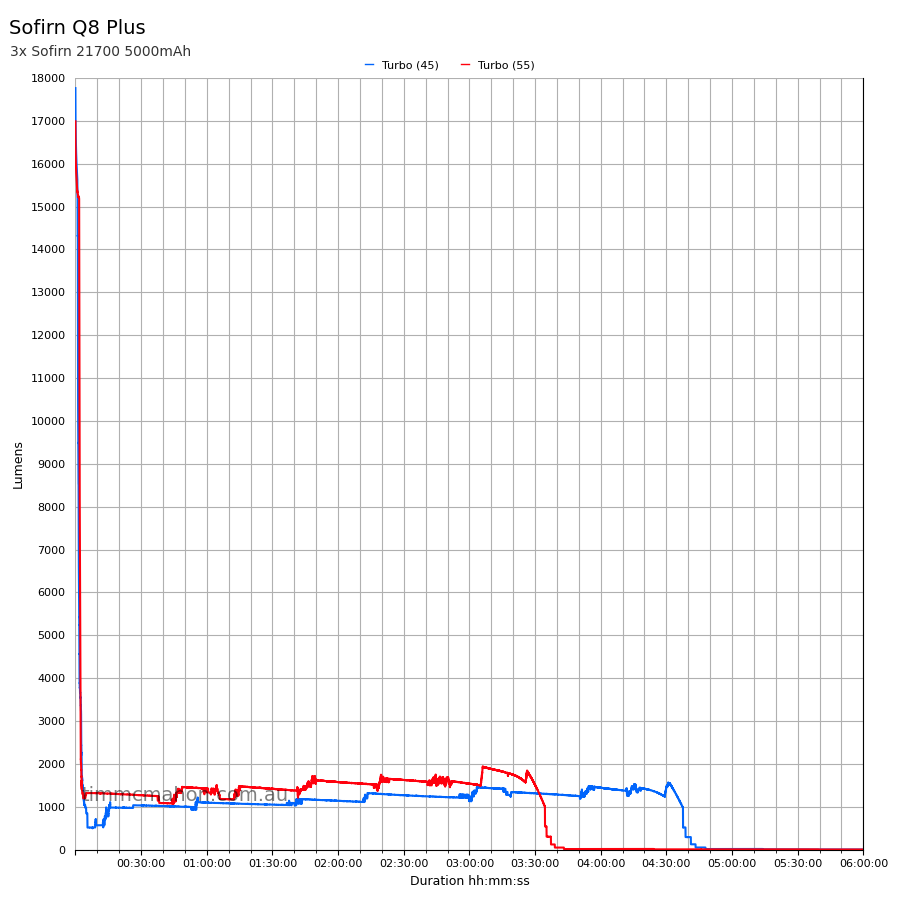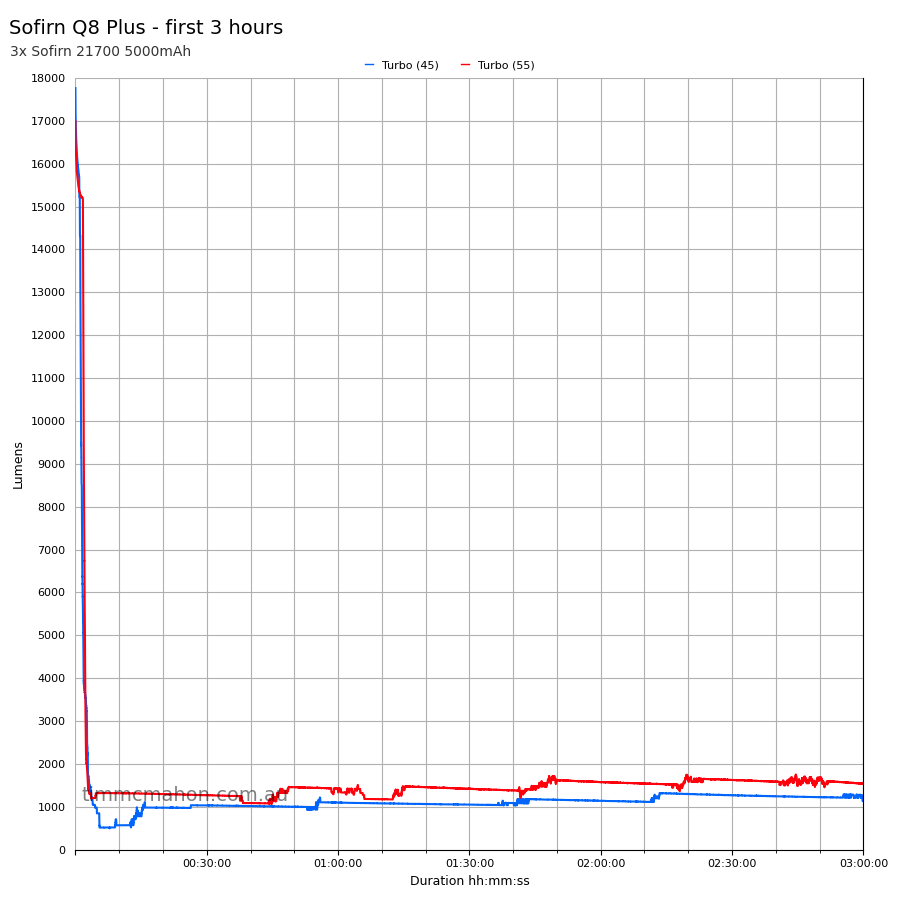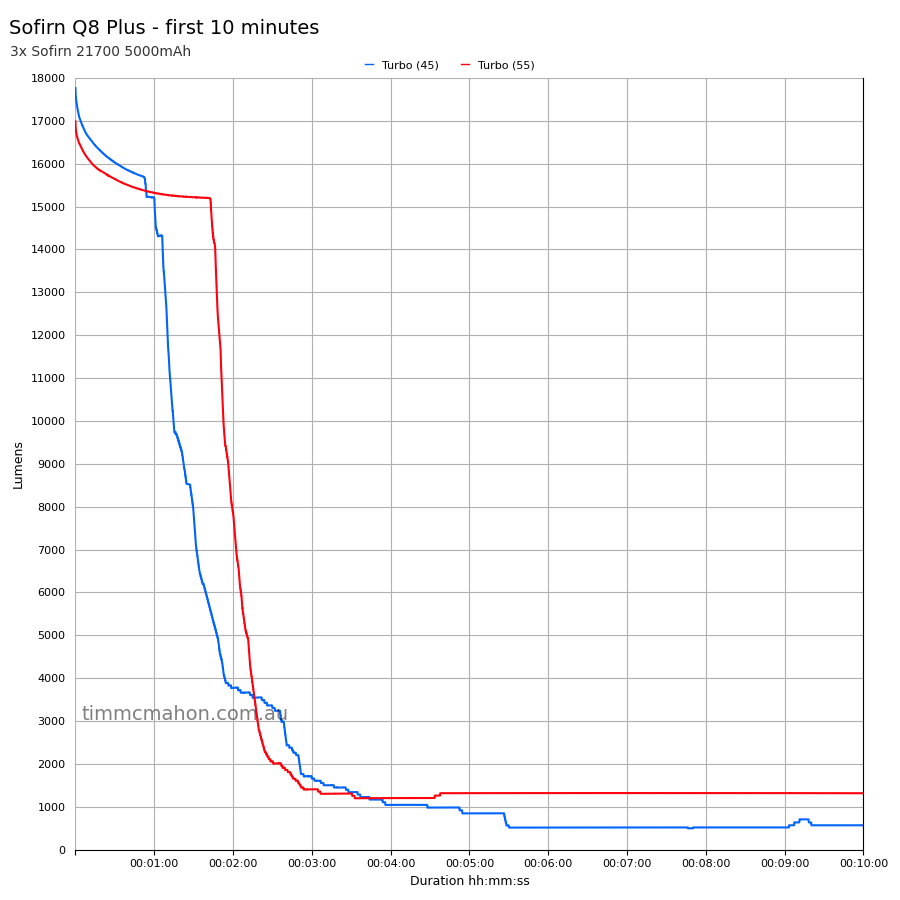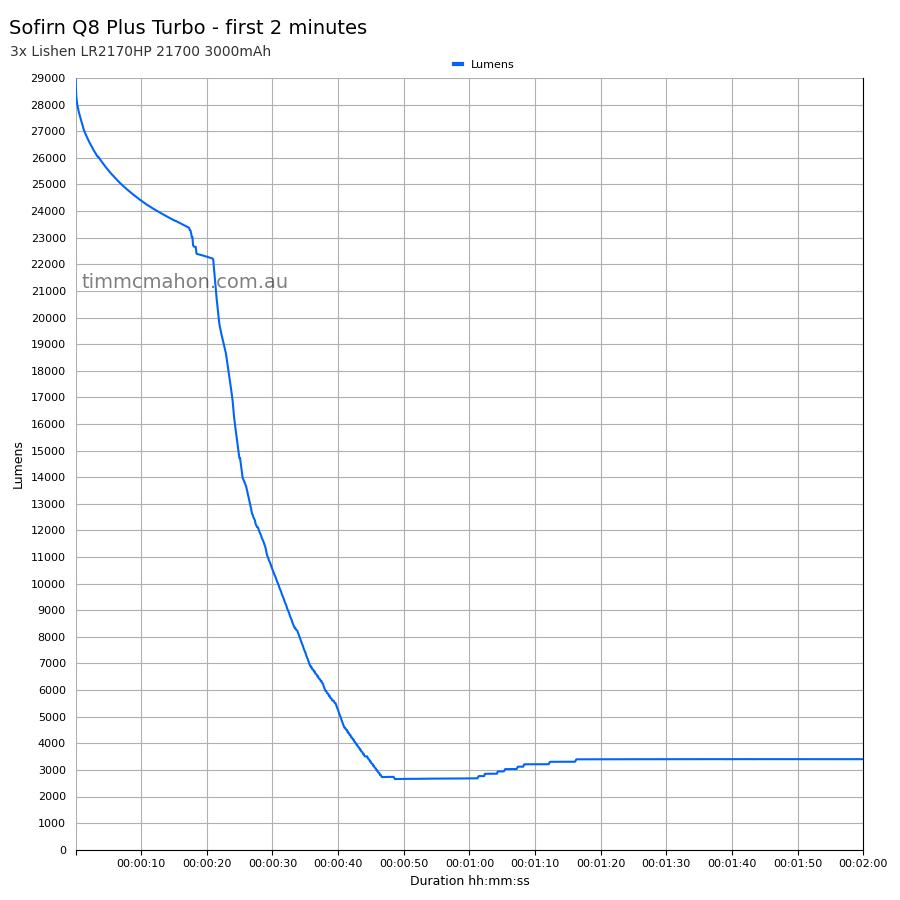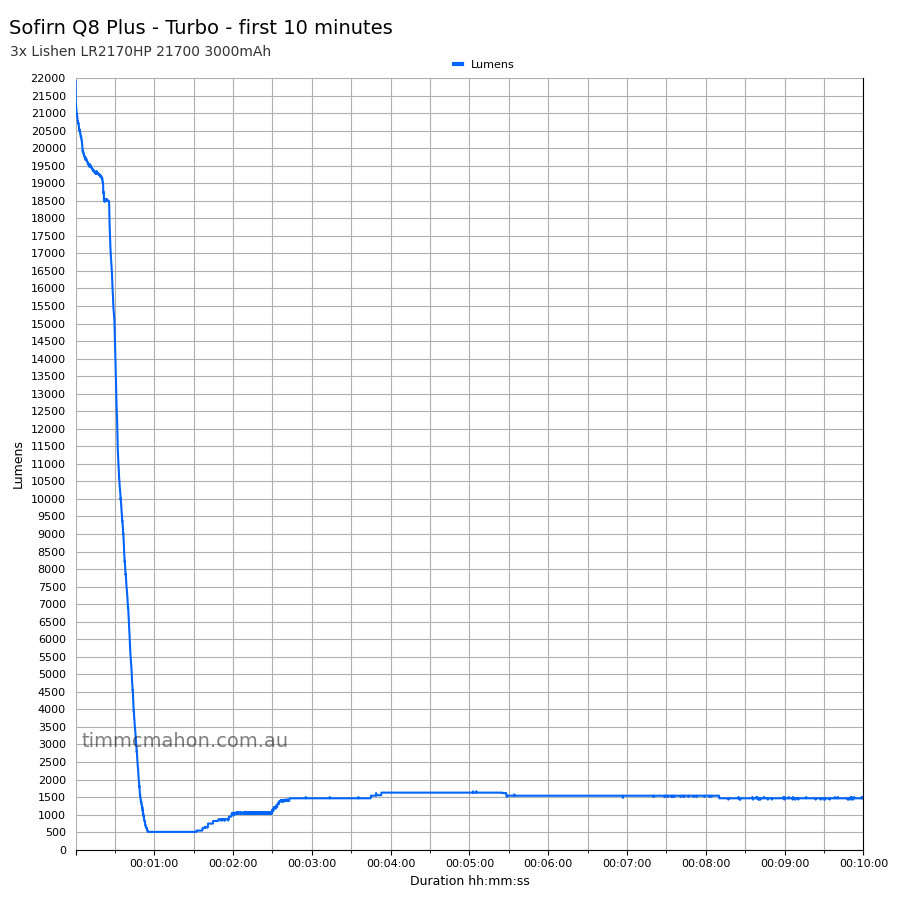Sofirn Q8 Plus Torch Review
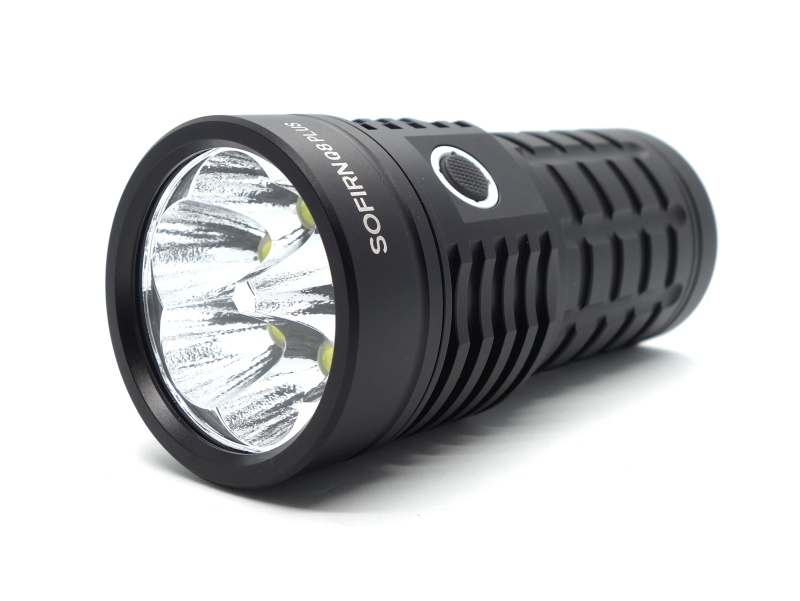
Sofirn Q8 Plus#
- Specifications
- Introduction
- Torch in use
- Build quality
- LED, bezel, lens, reflector and beam
- Size and comparison
- User interface
- Batteries and charging
- Performance
- Beamshots
- Conclusion
- Price
- Product page
Specifications#
| Brand/model | Sofirn Q8 Plus |
|---|---|
| LED | 6*CREE XHP50B 6500K |
| Maximum lumens | 16,000 lm |
| Maximum beam intensity | 76,666 cd |
| Maximum throw | 554 m |
| Battery | 3*21700 |
| Onboard charging | Yes (USB-C) |
| Power bank | Yes (USB-C) |
| Material | Aluminium |
| Modes | Many (Anduril 2) |
| Blinkies | Many (Anduril 2) |
| Reflector | OP |
| Waterproof | IP68 |
| Review date | November 2023 |
Introduction#
The Sofirn Q8 Plus is a soda can style torch with six CREE XHP50B emitters, three 21700 cells, USB-C charging, a power bank feature and a tripod mount.
Sofirn originally sent this torch for review in 2022 but I pushed it beyond its limits (28,987 lumens!) and broke the driver. There are more details about that below. Lesson learnt: Don’t push a torch beyond its limits until after a review is mostly complete!
When Sofirn announced on BLF that they would have a live stream on YouTube, I set a reminder and later joined the live chat. Barry mentioned that there might be version of the Sofirn Q8 Plus with a simple user interface in the future. In the meantime, he kindly sent the Sofirn Q8 Plus with Anduril 2 for review.
Sofirn very kindly sent a second Sofirn Q8 Plus for review. I have not been paid for this review nor have I held back my opinions of this torch.
There have been a few changes since the first Sofirn Q8 Plus.
Packaging#
The Sofirn Q8 Plus comes in a large white box. An outer cardboard sheath has an image of the torch while a white box inside has a flap that can be lifted to reveal the torch.
The following was included in the box:
- Sofirn Q8 Plus.
- 3*Sofirn 21700 5000mAh cells.
- Two spare o-rings.
- USB-A to USB-C cable.
- User manual.
Torch in use#
The Sofirn Q8 Plus feels pretty hefty! It fits my hand comfortably but it is giving my arm a bit of a workout.
Thankfully, there is a 1/4 inch threaded hole that allows the torch to be mounted to a tripod for handsfree use.
This torch is suitable for producing a massive wall of light to giggle at. But you could mount it to a tripod and use it to light up a work area for hours.
Build quality#
The Sofirn Q8 Plus is made of aluminium and it has a matte black anodised finish. There are no sharp edges.
There is plenty of grip on the tube.
The button gives a satisfying click.
The threads for the head came lubricated. The head turns smoothly.
The threads on the tailcap, for bypassing the springs, did not come lubricated. The tailcap required a bit of force to unscrew. I don’t think Sofirn want people to accidentally unscrew the tailcap.
Sofirn didn’t bypass the tail springs with wire to improve the performance in this second Q8 Plus (left). They bypassed the springs in my first Q8 Plus (right).
There are three pads on the driver for updating Anduril. Thanks Sofirn!
Oh, no! The centre pad isn’t negative (ground).
Sofirn, could you please ensure that the centre pad is negative on upcoming models so that it’s easier to update Anduril?
Updating the firmware#
Anduril is an open-source firmware for flashlights, distributed under the terms of the GPL v3. The sources can be obtained here:
A USB-C to UPDI V2 adapter by gchart would have worked if the centre pad was negative. I assembled and tested thirty V2 adapters for enthusiasts in Australia (feel free to reach out if you are interested; note: it doesn’t work with the Q8 Plus).
thefreeman made an adapter that has three extra through-holes so that you can attach your own wires and pogo pins to make the adapter work with the pad layout on a Q8 Plus:
WTS : Flashing adapters for Attiny1616 driver
There are a few BLF members selling programming adapters:
gchart (USA and global)
thefreeman (Europe and global)
TimMc (Australia)
LED, bezel, lens, reflector and beam#
The Sofirn Q8 Plus comes with six CREE XHP50B 6500K emitters. It has a deep orange-peel reflector with a flower-like pattern.
There does not appear to be any anti-reflective coating on the glass lens.
I was able to unscrew the bezel with two strap wrenches.
There is a plastic ring sitting inside the bezel with a glass lens pressed against it. An o-ring was sitting between the reflector and the glass lens.
Each CREE XHP50B emitter has a white gasket around it to help keep the reflector aligned.
The MCPCB is screwed down and has six wires going to it from the driver.
I desoldered the wires and cleaned off the thermal paste on my first Sofirn Q8 Plus.
Tear down#
20awg wire has been used between the driver and the MCPCB.
There are three FETs and 7135 regulators on the driver. Each one is driving two emitters.
There is an Injoinic IP5310 SoC for the charger and power bank. It supports 3A charging and 3.1A discharging.
The microcontroller running Anduril 2 is an ATtiny1616.
CCT, CRI, and duv#
I have taken Correlated Colour Temperature (CCT) and Colour Rendering Index (CRI, RA of R1-R8) measurements with the torch positioned one metre away from an Opple Light Master Pro III (G3) for each step and two metres away for Turbo.
The CCT is between 5800K and 6400K. The CRI is around 67.
The Delta u, v is positive (green) on lower modes and less green on higher modes.
The beam produced has a white hot spot, a green corona and a purple spill.
| Mode | CCT (K) | CRI (Ra) | x | y | Duv |
|---|---|---|---|---|---|
| Step 1 | 5832 | 66.7 | 0.3248 | 0.3468 | 0.0064 |
| Step 2 | 5826 | 66.8 | 0.3249 | 0.3468 | 0.0063 |
| Step 3 | 5850 | 66.9 | 0.3244 | 0.3459 | 0.0061 |
| Step 4 | 5862 | 67.0 | 0.3242 | 0.3455 | 0.0060 |
| Step 5 | 6221 | 68.7 | 0.3176 | 0.3330 | 0.0028 |
| Step 6 | 6302 | 69.2 | 0.3163 | 0.3304 | 0.0021 |
| Step 7 | 6378 | 69.5 | 0.3151 | 0.3281 | 0.0015 |
| Turbo | 6193 | 68.8 | 0.3182 | 0.3330 | 0.0025 |
Calculate Duv from CIE 1931 xy coordinates
Dimensions and size comparison#
Dimensions#
I took the following measurements using a digital caliper.
| Measurement | Unit (mm) |
|---|---|
| Length | 133.0 |
| Head diameter | 63.0 |
| Tube diameter | 54.0 |
| Tailcap diameter | 54.0 |
| Battery length | 71.0 |
| Battery diameter | 21.6 |
| MCPCB thickness | 1.97 |
| MCPCB diameter | 49.99 |
| Lens thickness | 2.98 |
| Lens diameter | 56.13 |
Weight#
I took the following measurements using a digital scale.
| Weight | Unit (g) |
|---|---|
| Sofirn Q8 Plus | 496.60 |
| Batteries | 205.89 |
| Sofirn Q8 Plus with batteries | 702.49 |
Size comparison with its competition#
From left to right: Lumintop Mach, Sofirn Q8 Plus, IMALENT MS12 MINI
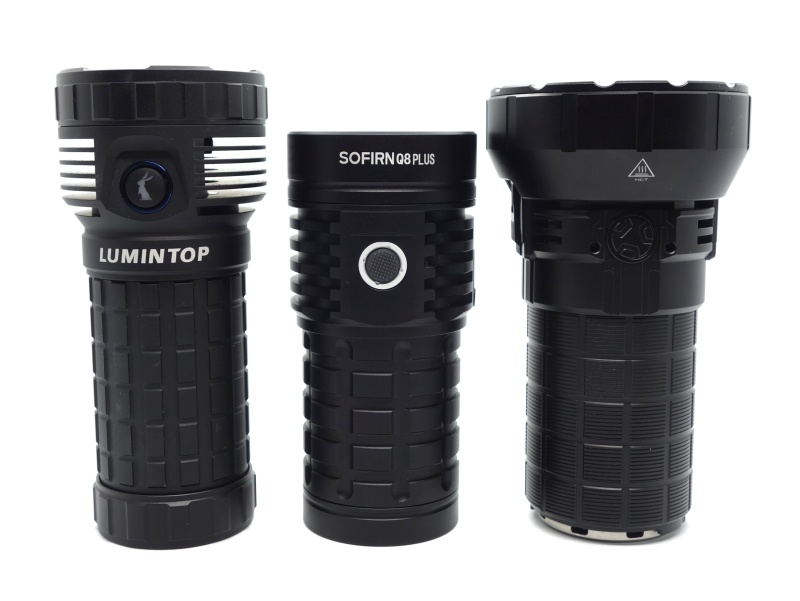
From left to right: Lumintop Mach, Sofirn Q8 Plus, IMALENT MS12 MINI
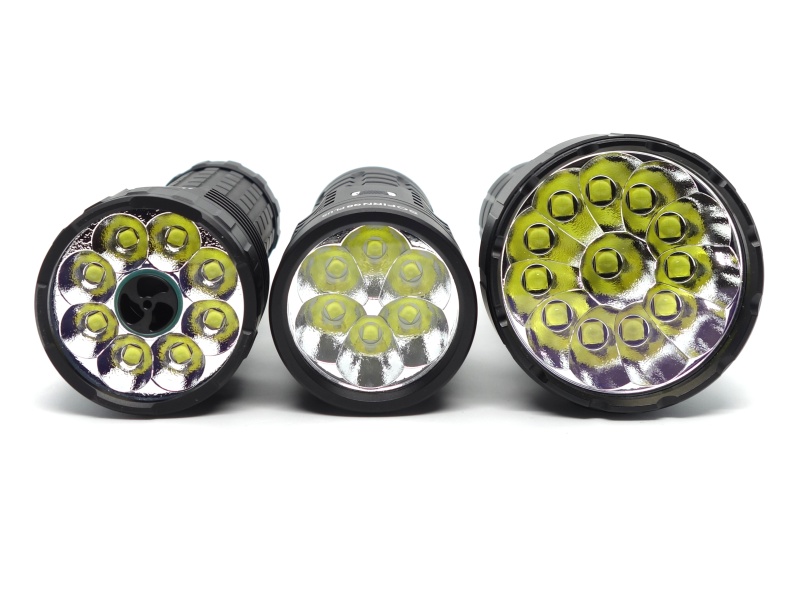
User interface#
The Sofirn Q8 Plus comes with Anduril 2 (version date 202202080614).
Anduril 2 has a simple user interface and an advanced user interface.
I highly recommend referring to the included user manual.
A text version of the user manual is available via https://toykeeper.net/anduril
Low voltage protection#
The user manual says that there is low voltage protection but I did not detect low voltage protection while powering the driver with my bench power supply.
I tested low voltage protection by connecting the driver of the torch to a bench power supply and then by lowering the voltage from 4.2V.
| Mode | LVP? | Cut-off voltage |
|---|---|---|
| Step 2 | No | 2.27V |
| Step 5 | No | 2.27V |
It would be good if the torch cut-off around 2.50V. Perhaps the voltage can be calibrated.
Batteries and charging#
Battery#
Three flat top Sofirn 21700 5000mAh cells were included inside the torch. The cells arrived with voltages of 3.65V each and they were isolated with a bit orange piece of plastic.
Sofirn previously supplied button top 21700 cells with the Q8 Plus. It would be nice if they revert back to providing button top cells. At least one Redditor has complained about the included flat top 21700 cells making poor contact (i.e. two of the three cells might not charge).
Charging#
The Sofirn Q8 Plus has built-in USB-C charging.
Power supply: PinePower Desktop USB-C
USB Meter: AVHzY CT-3 (recommended by LiquidRetro)
Room temperature: 18 C
I charged the included battery from 2.86V to 4.20V using the built-in charger. It took about 6 hours 46 minutes to fully charge.
The charging status indicator flashes blue while charging and turns a solid blue when charging is complete.
Power bank#
I was able to use the Sofirn Q8 Plus to charge my phone with a charging rate of 5V 2.5A using a USB-C to USB-C cable.
Power supply compatibility#
I tried the following power supplies with the built-in USB-C charger:
| Power supply | USB Type | Protocol | Does it charge? |
|---|---|---|---|
| Apple 61W Power Adapter | USB-C | PD | Yes |
| Google Pixel Power Adapter | USB-C | PD | Yes |
| PinePower Desktop | USB-C | PD | Yes |
| PinePower Desktop | USB-A | QC | Yes |
| PinePower Desktop | USB-A | Yes |
USB-C to USB-C charging works.
Performance#
Specifications from the manual:
| Mode | Turbo | High | Medium | Low | Moon | Ramping |
|---|---|---|---|---|---|---|
| Output (lumens) | 16,000 | 7,000 | 1,800 | 200 | 5 | 5-16,000 |
| Runtime | 2h 36min | 4h 32min | 10h 16min | 27h 45min | 40d | |
| Beam Distance (metres) | 554 | 355 | 155 | 52 | 8 | |
| Beam Intensity (cd) | 76,666 | 31,591 | 5,975 | 683 | 16 |
I am not sure how Sofirn came up with the modes in the ANSI/NEMA FL1 Chart. Below is a table that shows what I think the modes correspond to in Anduril for this torch.
| User manual mode | Anduril mode |
|---|---|
| Turbo | Turbo |
| High | Step 7 |
| Medium | Step 5 |
| Low | Step 3 |
| Moon | Step 1 |
I used the included flat top 21700 cells for testing. The Sofirn Q8 Plus was factory reset before testing. I manually calibrated the temperature and I set the temperature limit to 45 C (default).
To see how the runtime is affected by the temperature limit, I raised the limit to 55 C for one Turbo runtime test.
Lumen measurements#
I used a UNI-T UT210E clamp meter to measure the current at turn on by connecting one Molicel P42A 21700 4200mAh cell.
| Mode | Amps at start | Specs | Lumens @turn on | Lumens @30 sec | Lumens @10 min |
|---|---|---|---|---|---|
| Step 1 | 0.01 A | 5 | 5 | 5 | 5 |
| Step 2 | 0.11 A | 50 | 50 | 50 | |
| Step 3 | 0.43 A | 200 | 207 | 202 | 202 |
| Step 4 | 1.05 A | 535 | 515 | 515 | |
| Step 5 | 3.75 A | 1,800 | 1,911 | 1,864 | 1,796 |
| Step 6 | 6.71 A | 4,418 | 4,259 | 1,707 | |
| Step 7 | 11.40 A | 7,000 | 8,161 | 7,755 | 1,044 |
| Turbo | 37.70 A | 16,000 | 17,764 | 16,032 | 571 |
| Turbo (55) | 16,000 | 16,989 | 15,645 | 1,318 | |
| Turbo (Lishen) | 16,000 | 21,919 | 14,563 | 1,502 | |
| Turbo (fail) | 16,000 | 28,987 | 10,544 |
Standby drain#
101 µA with the switch LEDs off.
150 µA with the switch LEDs on Low.
1.3 mA with the switch LEDs on High.
Measurements were taken using a UNI-T UT139C digital multimeter.
Runtime graphs#
I used my own DIY lumen tube with a TSL2591 sensor and forked bmengineer’s project RuTiTe to record runtimes.
Note: Lumen measurements may be off by 10% with my DIY lumen tube.
The room temperature was approximately 18 C.
45 C vs 55 C temperature limit#
A fellow Aussie torch enthusiast strongly recommended doing some runtime tests with a higher temperature limit instead of using the default 45 C limit. I set the limit to 55 C and tested Turbo again.
Here is a comparison between a Turbo runtime with a 45 C limit and another with a 55 C limit.
The sustained output is higher and the runtime length is lower when the temperature limit has been increased to 55 C.
Pushing the Sofirn Q8 Plus to the limit#
I ended up damaging my first Sofirn Q8 Plus a year ago while attempting to push it to the limit. It reached 28,987 lumens at turn on. Two LEDs became permanently stuck on.
This incident changed how I review torches. I now wait until I have completed all of my tests before trying to do something that could damage the torch (thanks Sofirn for being so patient!).
After completing all my tests for this second Sofirn Q8 Plus I decided to see if I could push it to the limit too.
I used the battery tube from my first Sofirn Q8 Plus where the springs were already bypassed and I inserted three high drain Lishen LR2170HP 21700 3000mAh cells. A 45 C temperature limit was set.
Turbo reached 21,919 lumens at turn on and 14,563 lumens at 30 seconds!
After 10 minutes, I turned the torch off and checked it for damage. The driver is ok.
Runtime#
Here is a summary of the runtime results:
| Mode | User manual | Runtime | Turn off | Final voltage |
|---|---|---|---|---|
| Turbo (fail) | 2h 36min | 2min+ | 2min+ | |
| Turbo (Lishen) | 2h 36min | 49s | 10min+ | 4.07, 4.07, 4.07 |
| Turbo (55) | 2h 36min | 2min 49s | 6h+ | |
| Turbo | 2h 36min | 3min 4s | 6h+ | 2.89, 2.89, 2.89 |
| Step 7 | 4h 32min | 40min 47s | 8h+ | 2.85, 2.85, 2.85 |
| Step 6 | 4h 54min 35s | 12h+ | 2.86, 2.86, 2.86 | |
| Step 5 | 10h 16min | 5h 40min 11s | 12h+ | 2.86, 2.86, 2.86 |
| Step 4 | 10min+ | 10min+ | ||
| Step 3 | 27h 45min | 10min+ | 10min+ | |
| Step 2 | 10min+ | 10min+ | ||
| Step 1 | 40d | 10min+ | 10min+ |
“Runtime” is the time until the output reduces to 10% of the output at 30 seconds (as per the ANSI/PLATO FL1 2019 Standard).
“Turn off” is the time until my DIY lumen tube no longer detects more than 1 lumen.
“+” indicates that the light remained on after recording had stopped.
With a 45 C temperature limit set, it was able to sustain:
- 15,000 lumens for a minute with Turbo.
- 7,500 lumens for 2 minutes 30 seconds with Step 7.
- 4,000 lumens for almost 7 minutes with Step 6.
- 1,700 lumens for 15 minutes with Step 5.
- 1,000 lumens for over 5 hour with Step 5.
The runtimes fell short of Sofirn’s claims.
The output fluctuates up and down slightly over time. It doesn’t have an annoying zig-zag pattern. But it could be better.
Throw#
I took lux measurements with a UNI-T UT383BT at 30 seconds. Step 1 was measured at one metre. Steps 2 to 7 and Turbo were measured at five metres.
| Mode | Specs (cd) | Specs (m) | Candela measured (cd) | Distance (m) |
|---|---|---|---|---|
| Step 1 | 16 | 8 | 15 | 7 |
| Step 2 | 125 | 22 | ||
| Step 3 | 683 | 52 | 875 | 59 |
| Step 4 | 2,425 | 98 | ||
| Step 5 | 5,975 | 155 | 8,900 | 188 |
| Step 6 | 21,175 | 291 | ||
| Step 7 | 31,591 | 355 | 40,650 | 403 |
| Turbo | 76,666 | 554 | 79,950 | 565 |
Beamshots#
I went to a local park and aimed the Sofirn Q8 Plus at a tree 70 metres away while using Turbo.
Beamshots were taken using a Sony RX100M2 using 3.2", f3.2, ISO 100, 5000K WB.
Sofirn Q8 Plus (Turbo)#
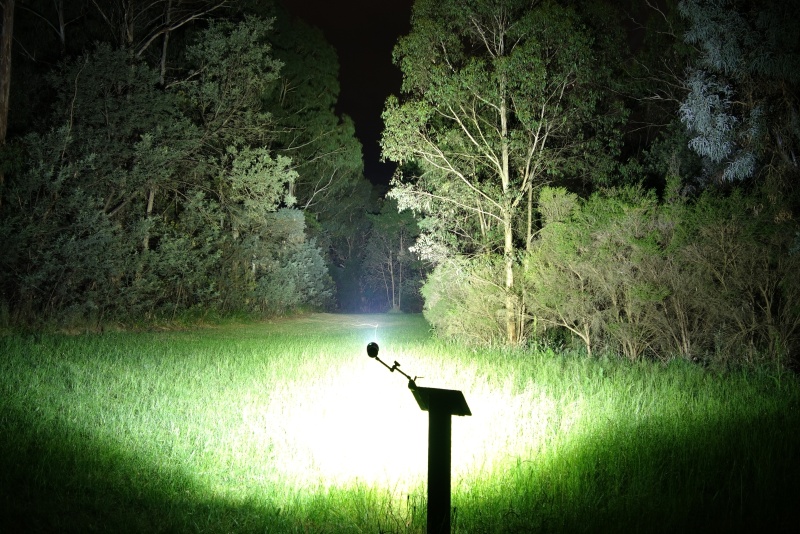
Sofirn IF30 Flood (Turbo)#
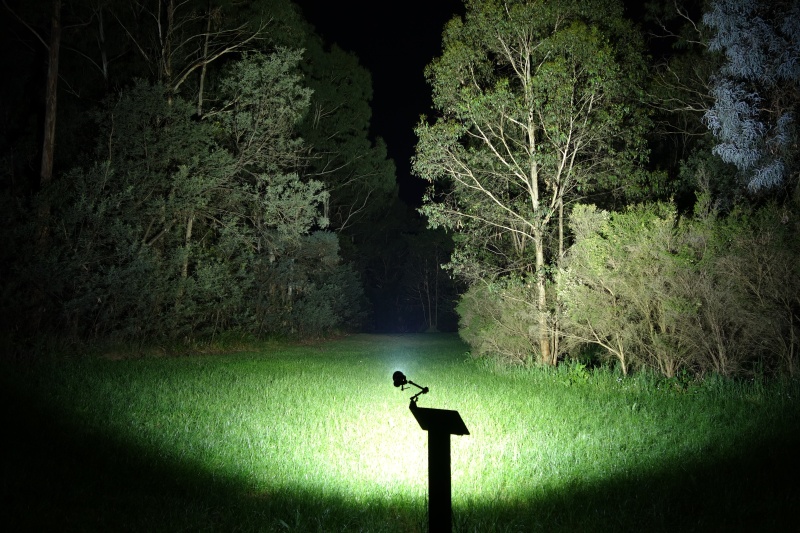
Lumintop Mach (Turbo)#
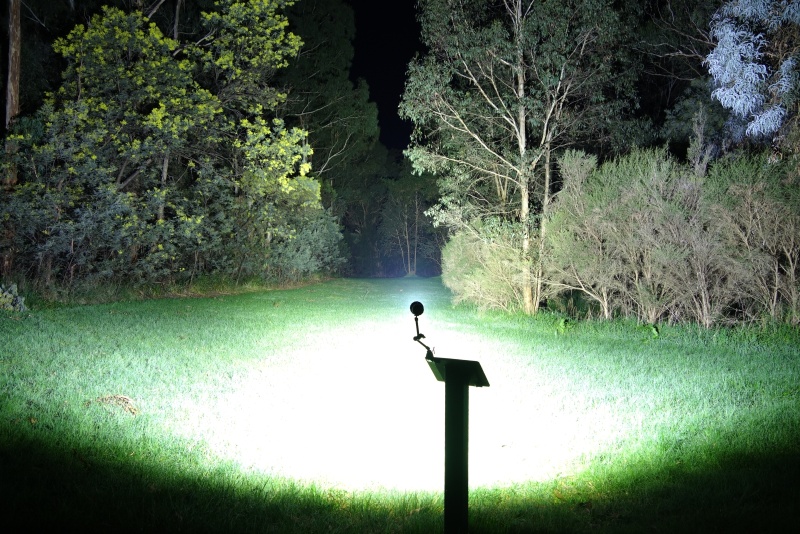
Nightwatch Chaos NS59v2 9xSFQ60.3#
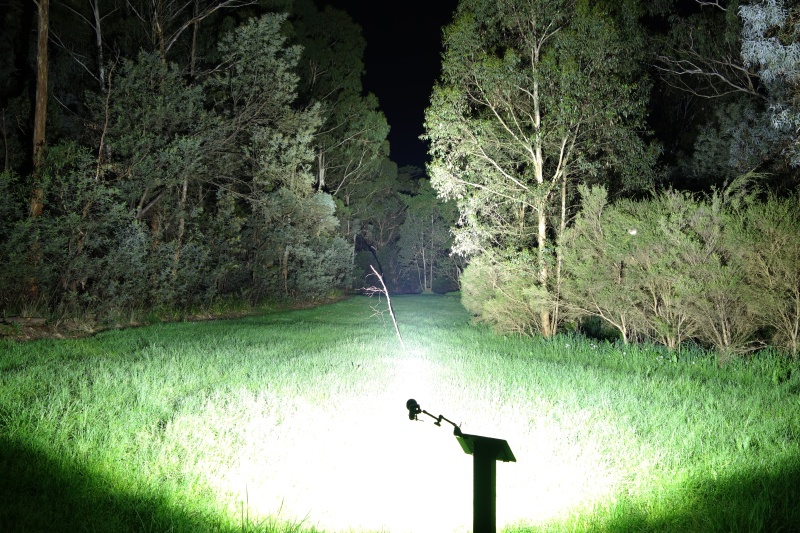
IMALENT MS12 MINI (Turbo)#
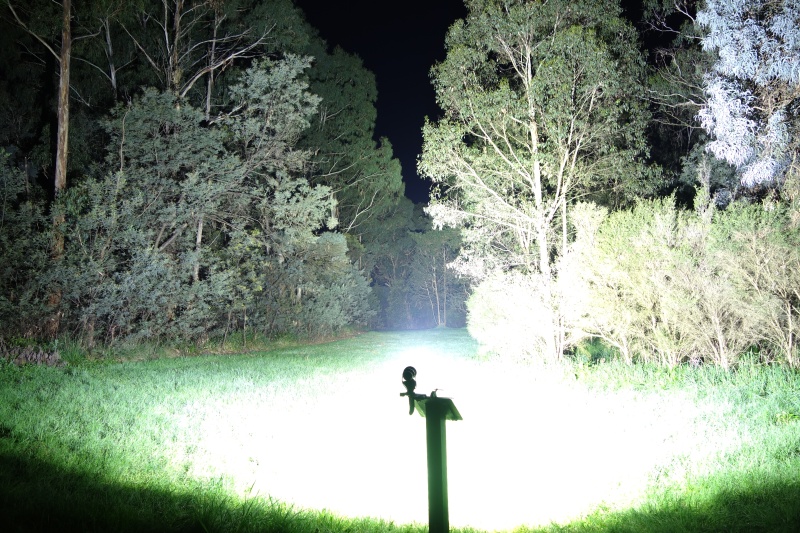
Conclusion#
The Sofirn Q8 Plus is a fun soda can style torch.
It is a lot of fun to tinker with as a torch enthusiast. I love how Sofirn has added programming pads to the driver and used Anduril.
The lumen output and beam distance slightly exceeded expectations.
The runtime fell short of Sofirn’s claims.
It would have been nice if Sofirn included button top 21700 cells and if they continued to bypass the springs.
I highly recommend the Sofirn Q8 Plus if you are looking for something to light up a work area for hours while mounted to a tripod.
Pros:#
- Good build quality.
- Lumen output is better than expected.
- Beam distance is better than expected.
- Tripod mount.
- Built-in USB-C charging.
- Power bank feature.
Cons:#
- Runtime is shorter than expected.
- Flat top 21700 cells.
- No more spring bypass.
- No LVP?
Price#
The Sofirn Q8 Plus with batteries is US$126.99 from sofirnlight.com at the time of writing.
Product page#
Sofirn Q8 Plus at sofirnlight.com
If you use an affiliate link, I may earn a commission.
